Since 1892, the Sierra Club has been the largest and most influential grassroots environmental organization in the United States. Ventana Chapter members are approximately 6000 of your friends and neighbors. Inspired by nature, we work together to protect our 127 miles of coastline, hundreds of thousands of acres of wild lands and our dwindling water supplies. (Ventana Wilderness from Bottchers Gap, Ventana Chapter file photo).

New Hike!
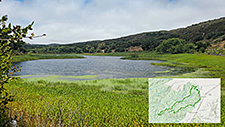
Click for full sized image
Hiking Northeast Ford Ord Loop
Saturday, November 8, 2025 9 AM - 12:00 PM
Fort Ord National Monument
663 Monterey-Salinas Highway, Salinas, CA
Fort Ord is a great place to get away from it all. The National Monument has incredible views, trees, ponds, wildlife and wide open spaces.
The loop is about 7.2 miles with 958 feet of elevation. There are multiple trails back if you want a shorter trip. It should take about 3 hours.
We will meet at the picnic table on west side of Creekside Terrace Trailhead parking lot..
Please read the entire description before registering.
Hosted by Ryan T.
|
Review of Jacks Peak Hike
Also a bit about staying safe while hiking
by Ryan Trundle
Fall 2025
Some very lovely people, via our Meetup Group, recently joined me for a beautiful 6 mile hike around Jacks Peak. The park was named after David Jacks, a 19th century Scottish immigrant who acquired thousands of acres of land through questionable means from Native Americans, Mexicans and poor farmers. He would have fit well in this administration. That being said it makes my heart glad the land is publicly owned and free to enjoy. It doesn’t make much sense to me that if I hoarded more shoes than I could wear in a hundred lifetimes I would have an illness but if I hoarded more land or money than I could use in a hundred lifetimes I would be admired. Hoarding is hoarding. I am not saying that just because I like shoes. It’s ok to have a nest egg, it’s ok to have a couple dozen shoes, it’s very much not ok to have more money than entire nations while paying off politicians so you can hoard more money at the expense of those most in need. Sorry, that’s what happens when I watch the news.
Back to the trail. One would expect this trail would be so crowded reservations are required, the opposite is true. We were the only ones in the easternmost parking lot and didn’t see anyone until the end. The trail we chose was 6 miles with a thousand feet of gradual elevation. Some up and downs but no very steep ups. The whole trail winds you through Monterey Pines and Coastal Live Oak. We went clockwise through the forest catching glimpses of Seaside and Marina. The turn takes you south where thick forest opens up to wide views of Carmel Valley.
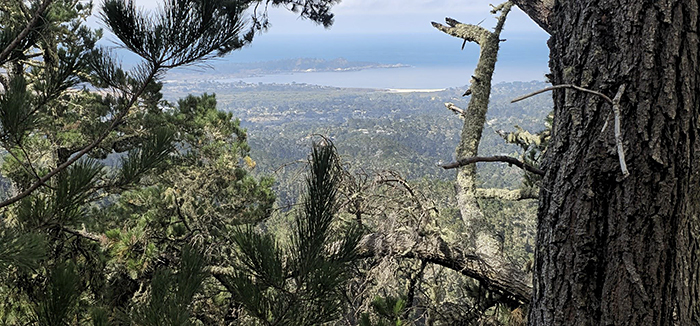
There is phone coverage the whole way if that’s something you worry about. Some people with medical conditions or social media addictions require this. Fortunately I have neither of these but do worry about others. Some phones now have satellite coverage by subscription or solely for emergency numbers. If you frequently travel beyond cell tower range you might consider a satellite communicator. I always have one hiking. They vary in price and function, mine was $150 plus another $25 a month for unlimited texting and weather checks. It has a SOS button for rescues and a “check in” button that when pressed sends your location to everyone you have added to a list with a preloaded “I’m ok” message. You can also connect it to your phone and text people back home in case you left the oven on or to tell them to bring in your shoe delivery. Some are more like a satellite phone and much more expensive. Some are only an emergency beacon and very inexpensive. I’m also certified in Wilderness First Aid, which isn’t like a Florence Nightingale Snow White mash up healing forest creatures as I had hoped but a high level First Aid for when help is hours away and your only resources are twigs and bandanas. Still useful I guess but whatever.
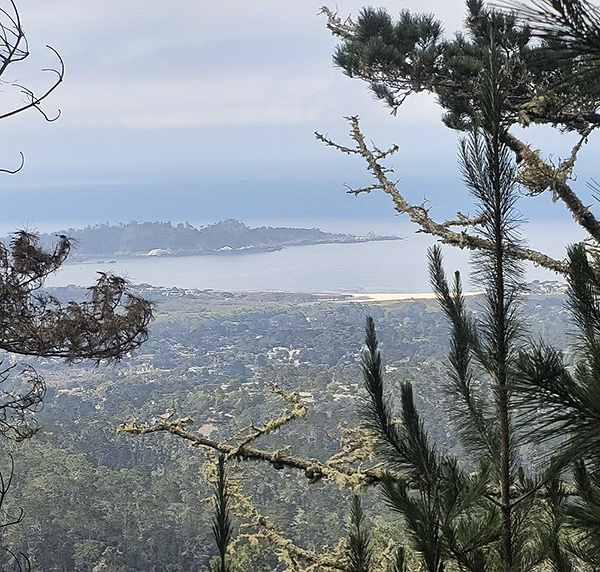
You are heading west now where it feels like the wilderness. No other people or buildings to be seen for a couple miles. Then bits of Carmel Valley come into view. Getting close to the west parking lot people start to appear, some have dogs with sweaters. I don’t know why. Your experience may vary. There are some wide open spaces here where you can see Carmel, Point Lobos and Fish Ranch. There is also a huge bench with a beautiful view that will fit 8 locals or 4 tourists. Keep going past the fossils and someone's back yard where you can see Monterey and Carmel at the same time to a steep downhill. I was a bit worried thinking about the climb back up but it’s much more gradual. Going counter clockwise would be a good workout. Heading back east is a gradual climb with views all the way to Santa Cruz and once again no people. The last half mile there are road crossings but no traffic. And we are back at the parking lot. Both parking lots I saw had clean bathrooms and water available. Puppies are allowed on the trail, just don’t be one of those people who bags the poop and leaves the bag on the trail. If you don’t want to carry it, get one of those dog backpacks and make them pack it out. It’s their mess anyway, maybe get a size larger so it fits over their sweater.
So I would very much recommend this trail if you like solitude, trees and views. It took us about two and a half hours plus a rest on the giant bench. Let me know if you want help choosing a satellite communicator or a trail or whatever;
Ryan Trundle
Andrew Molera State Park Review
Also, What’s the Deal With Hiking Sticks?
by Ryan Trundle
Late Summer 2025
When I daydream about hiking this is what it looks like. Breathtaking describes both the views and the climb.
The hourish drive down was beautiful although littered with tourists. Once again I find myself wishing for nerf bumpers, especially around Bixby bridge. Traffic eases up past there. It was a sunny day so the parking lot was full of people heading to the beach north of the trail. They do charge for parking but have restrooms, water and a nature center.
Follow the passels of children and parents dragging giant coolers across the wooded walkway over the river down a wide road for half a mile. Turn left. The guide says the first two hills are fairly steep. I would like to dispute their definition of hills. You will go up, down, up and down again thinking that wasn’t so bad. That wasn’t the two hills though. It keeps going up for another mile. It’s more like two mountains with a bunch of little hills on them like a Stegasourus.
Thinking it might be difficult I got out my hiking sticks early. People seem to have mixed feelings about hiking sticks. Some people refuse to use them. I wore out most of my joints playing rugby for more than twenty years while generally treating my body like a rent car with full coverage so I very much appreciate them. Uphill it’s a great workout for arms while keeping knees from screaming so loud. Downhill they keep my weak brakes in check. Going across rivers on slippery rocks it’s like having four wheel drive, I haven’t fallen in since I started using them. Most long distance hikers use them as well no matter their age. They aren’t indispensable but sure do come in handy, kind of like sneaking a six pack of beer into your friend's pack.
Make sure you stop a couple times on the way up and turn around. The view is incredible. Towards the top of the second mountain there is a nice bit of Redwoods. A little ways on the other side of the top is miles of coastline to the south. The day I went it was foggy five miles south of the trail, five miles west and five miles north. The trail down is hard only in the sense that the ruts are deep and you are too busy gawking at the view to pay attention to your footing so stumbling is frequent. Fortunately my hiking sticks saved me from wiping out.
Half a mile going north along the coast turn left, over a pile of driftwood and onto your own private beach. There was no one when I got there, no one while I ate my lunch and no one when I left. It was a travel magazine cover amazing with white sand, waves crashing and small puffs of fog floating by.
I could have stayed for days but only brought one sandwich. The last mile hugs the coast line until you see the beach everyone went to. It actually looks like a fun little protected cove for paddle boarding and what not.
That’s it. Highly recommend this hike. If the hills (aka giant mountain) is too much for you, do an up and back of the coastline and visit the beach. Until next time! Also don’t forget to follow us on Meetup for group hikes https://www.meetup.com/sierra-club-ventana-chapter/ If you have any questions or suggestions for future hikes send me an email at
Elkhorn Slough Review
AKA Elkhorn Slough National Estuarine Research Reserve
Also a bit about shoes
by Ryan Trundle
This may be the best one-size-fits-all hikes around. Do you like birds? Got thousands, especially during migrations. Do you like sea otters? Yep. Sea lions? Sometimes. Great huge views where you can see for miles? That too. Flowers, trees, and wide open spaces? Plenty! Really smart and nice people there who tell you all about what you see? That too. Long trails, short trails, bridges, and an island? Of course.
Contrary to my usual method of trying to google flora and fauna I see on my hikes with zero bars we took an opportunity to hike around the research reserve with a docent who is like your own Elkhorn Slough Wikipedia but with a great personality. They have guided hikes with a naturalist every Saturday and Sunday at 10 AM and 11 AM. More information can be found here https://elkhornslough.org/reserve/.
You can find the Elkhorn Slough National Estuarine Research Reserve conveniently located halfway between Monterey and Santa Cruz on Elkhorn road. There is no charge for parking. There are restrooms and water available. Be sure to check out the nature center at the beginning, it is full of interesting displays. They also have information displays on trail,
Our Docent (who was amazing!) led hike went counter clockwise while they pointed out the incredibly diverse flora and fauna. Unusually I go clockwise while turning left at every intersection, turn left twice at the dead ends. If you walk every foot of every trail you might travel six miles. Total elevation change is around 250 feet.
The south loop with two offshoots leads you around a couple large ponds, or maybe small lakes full of pelicans, egrets and herons. Small hills with oak trees scattered about grassland make up the rest. Be sure you go out to Parsons Slough Overlook for a nice panorama. Heading back north winds you down to the wetlands. There is a walkway that takes you over the water.
Follow the trail over another bridge then turn left to the island. Watch out for trains and the young sea lion that has been hanging out around the oyster beds. The island has a nice bench right on the slough with a great view of kayakers. It would be quite easy just to stay there watching the hundreds of birds but you have a couple miles to go and the park closes at 5. Back across the railroad tracks turn left, up the hill to a nice viewpoint. Give me a wave, I can see it from my house.
A left turn takes you past ponds full of ducks. They are usually very busy doing duck things while chatting to each other the whole time. The wide path leads you in the shade of oak trees past a few more ponds and back to the parking lot. Here is the Alltrails map I made. Elkhorn Slough Map at AllTrails
I have a list of the most asked hiking questions and will try to answer them all eventually. The top one was what shoes to wear. Full disclosure, I might have a slight shoe hoarding problem. I may also tend to check what other people are wearing. The best place for shoe watching is Point Lobos. You will see everything from flip-flops to shiny high heels to crampon ready mountaineering boots. So what shoes are best for you? There are thousands of choices. My feet are flat and wide like Fred Flintstone so I like Altra and Topo Athletic shoes. According to a website that does long distance trail surveys, halfwayanywhere.com, the ten most popular trail footwears on the PCT were all trail runners. They are light and super comfortable. I also go through at least three pairs a year as they are not super durable. The softer sole grips better but wears faster. A hiking boot can last decades with resoling but take a year to break in and feel like cement on a cold day. Whatever you get, make sure they are comfortable with a good tread. Don’t think about it too much. It’s fun to get the newest gear but not necessary. There was a 67 year old woman, Emma Gatewood, who hiked the Appalachian Trail wearing a pair of Keds and carried everything in a denim sack. Her shelter was a shower curtain.
If you haven’t yet, follow us on Meetup for hikes and whatnot. Remember the important part is getting out there even if all you have is a shower curtain and Keds.
How far can you hike?
And review of the Fort Ord Mudhen Lake and Rim Trail Ramble
by Ryan Trundle
The Mudhen Lake and Rim Trail Ramble at the Fort Ord National Monument is a 14.5 mile loop, technically a quadruple loop, that took me a little more than 6 hours to complete. I tend to stop to look around a lot. There was also a lunch break. It was moderately difficult for me. A blue run you might say. Not much elevation change but a nice stretch. I use Alltrails, here is the link. Mudhen Lake and Rim Trail Ramble. I am sure there are a few apps that are as good. I use it to know how fast I’m going and it alerts me when I miss a turn being too busy looking at the views to notice the trail markers. It isn’t very hard to take a wrong turn at Fort Ord either. The trails map looks like a smashed windshield labeled with random unsequential numbers. On the bright side if you miss a turn just take the next one.

The trailhead is clearly marked with limited parking. No water or restrooms so get and go before you go and git. The first mile or so parallels a road with intermittent subdivisions. It was a bit foggy in the beginning walking through low oak trees covered in Spanish Moss. Fortunately a mountain biker hit the trail before me and took care of the spider webs. Past some empty ponds, a couple old army buildings and some very nice goats the sun came out and terrain opened up.
There were a few mountain bikers on the trail but they were polite. If you don’t know they will alert you when coming from behind with a “On your left”. If you feel like an uninvited handlebar ride move left, to get out of the way move right. Legally hikers have the right of way but I don’t quite get that, it’s much easier for hikers to step out of the way so I do. Hikers and bikers are supposed to yield to horses which I get. I don’t know who horses yield to, maybe Llamas?
The next few miles climb up a bit through sparser trees and eventually hilly scrubs. Wide open spaces with great views of Salinas and Simas peak. Up and down little hills with twists and banked turns. The trail map has you doing a double figure eight but I just went clockwise.
Given a choice I like getting most of the elevation gains in the beginning of the hike and downhill at the end. That’s what my knees tell me anyway. Really steep trails in either direction hurt. I played rugby for more than 20 years breaking, spraining or tearing just about every part of me. Luckily the multiple concussions let me forget that when I’m planning a hike. Taking my body on a hike is like taking a demolition derby car on a road trip. The brakes don’t work, the engine barely goes and the whole thing sounds like it’s falling apart. You’re not sure if you will make the trip but at least you aren’t worried about a few more dents. Also in a pinch it will run on alcohol. So far I haven’t had to be towed back home so there is that. I can go about 25 miles on a good day, sometimes I turn around after just a few miles. Sometimes I pass people, sometimes I get passed. When you are figuring out your fitness level all that matters is you get where you want to go. Optimally you also want to be able to walk the next day as well.
It’s not a race. It’s not a marathon. It’s walking around and looking at things.
My pack is too heavy, my belly is too big, and I wear swim shorts hiking but I get out there and have a great time. I don’t worry about anything but that last part. The only fitness level I make sure to know is when I am at half of how far I can go that day. If you know that you will always make it back to the car.
Back on to the trail on the back end of the trail there are a couple of perfect ponds full of ducks and maybe a couple geese. There is a bit of up and down but not too bad. Most of it is a nice narrow trail. There are some dirt roads and a small amount of regular road. The changes and scenery keep it interesting. The last section are Savana like fields before you get back into the thicket of short oak trees. That’s about when you start to see people again.
All things considered it’s a really nice place to wander around looking at stuff with many completely different ecosystems.
I think we will do this hike again soon. We are posting group hikes here https://www.meetup.com/sierra-club-ventana-chapter/ It’s free to join. If there are any outings you would like to see or any questions feel free to email me
.
Remember, it’s not a race. It’s not a marathon. It’s walking around and looking at things. Hike your own hike and have fun out there.
Ryan Trundle
Where to thaw out?
by Ryan Trundle
Welcome to my second article. Hopefully you enjoyed the last one enough to not run away from this one.
Like many of you I spend most of my summers in an ethereal polar bear plunge. I am talking about the June gloom gaseous ice bath fog that tends to overstay its welcome by a couple months. Most of the time I appreciate the beauty of it but eventually my memory of the miserableness of sweltering in blistering heat has faded enough I want to go hike somewhere warm. That is what happened to me Sunday after spending Saturday shivering. Ironically I woke up to sunshine Sunday.

Anyway I decided to visit Stevens Creek County Park and hike the Canyon Trail. Just an hour's drive from Elkhorn Slough in Cupertino. I usually try and find a nice local place for breakfast but woke up too late for that this time. Breakfast recommendations are always welcome. G-Maps led me there without incident as it’s not far off the beaten path. The only issues on the road were dozens of middle aged men in spandex fighting for the Lanterne Rouge. More power to them but sometimes I wish they made nerf bumpers. I stopped at the first parking lot and paid the $6 fee twice. It's a credit card only machine which another hiker did not have so I gave them mine. Just past the first parking lot there is a little building with a fountain for water in case you forgot to fill your tanks.
The trail itself starts out pretty easy, I did’t get out my hiking sticks the whole time so I would rate it moderate although the heat added a level of difficulty towards the end. The Alltrails app claimed I went seven miles while my phone's pedometer said I went 8.2. Split the difference and call it 8 even. It took me about 3.5 hours going clockwise.
Dogs may be required or issued at the entrance. They must have ran out before I arrived because everyone else had one but me. I said “Hello, pretty puppy!” 37 times in 3.5 hours. In Louisiana my eldest daughter and I went on a hike co-sponsored by the SPCA and everyone actually did get a dog. I would love to do that here so if you have a shelter contact up let me know please.
Be sure to pay attention to the signs. This one warns of giving fish cutlery. |
|
This one advises you not to go swimming with your bicycle. |
The first couple miles follow the reservoir and are nicely shaded. The water was bluer than the Caribbean.
This was around noon and the temperature was still in the lower 80s. There still were plenty of people to talk to and puppies to pet. Around mile 2 our trail takes a left turn and the uphill begins. And up and up and up. It’s a nice grade though, not too steep like some of these around here. There are a few local “trails” here I am certain were originally meant for only donkeys and pack mules.
The next couple miles wound their way through the trees with a few exposed areas. Nice views here and there. At the halfway point there is another parking lot, picnic table, bathroom and water spigot. Maybe be a nice lunch break spot, you could even have pizza delivered.
Half a mile past that the trees go away and the temperature rises exponentially. I can actually hear my Irish skin sizzling. Bug spray or netting isn’t a bad idea in this part. Little face flies ride the dust up your nose. You might consider running back to the cool water of the reservoir at this point but that would be a mistake. In just another apocalyptic hell fire half mile I made to the top where you can see from Gilroy to downtown San Francisco. It is totally worth the 8th degree sunburn. I don’t have a picture that does it justice so we’ll just leave that up to your imagination.
A bit of downhill and you are back at your car and I am at the end of this review. I would for sure hike this again maybe in the fall which brings me to the announcement. We have a Meetup group and an Instagram page. Please join! The Meetup name is Sierra Club Ventana Chapter of course. The Instagram is @centralcoasthiker831. There is nothing on them yet so it’s the perfect time to join, follow them. I am also about to post our first outing on Meetup which will be a tour of an amazing, wildlife filled, local trail system guided by one of their brilliant staff.
What outings would you like? Let me know.
TTFN,
Ryan Trundle
 Mount Bago as seen from Kearsarge Pass. Bullfrog Lake is in the center of the photo. Mount Bago as seen from Kearsarge Pass. Bullfrog Lake is in the center of the photo.
Mt. Bago, 11,870'
July 1-6, 2025
by Debbie Bulger
photos by Richard Stover
The view from the top of Mt. Bago is one of the finest in the Sierra. Climbing Bago is considered “easy” by peak bagger standards, but somehow becomes harder the older one gets. The easiest way to get there is to surmount Kearsarge Pass which at 11,760 feet is almost as high as Mt. Bago. One then drops about 1,400 feet to Charlotte Lake.
Starting from the Onion Valley Trailhead at 9,100 feet, Richard Stover and I hiked the 4.7 miles to the the pass. We had camped at Onion Valley for two nights to acclimatize and hiked the 4 miles round trip to Robinson Lake as a warm up the day before.
The flowers were in their full glory, especially in the wet areas around creeks and seeps. We spotted leopard lilies, rock fringe, Labrador tea, shooting star, rein orchids, various penstemon, mountain pennyroyal, cinquefoil, various buckwheat, and many more. Quite a show. I always feel exhilarated when surrounded by mountains and native plants.
 Rock Fringe. Rock Fringe.
The pass was cold and windy.
We dropped to one of the Kearsarge Lakes on the west side and barely had time to set up camp before dark. Our neighbors were a mother Sooty Grouse and her chicks. |
|
 Labrador Tea Labrador Tea
|
 Debbie and Richard at Kearsarge Pass. This was the 6th time I have gone over this pass on the way to various peaks.. Debbie and Richard at Kearsarge Pass. This was the 6th time I have gone over this pass on the way to various peaks..
The next day we passed spectacular Bullfrog Lake (no camping allowed) and found our way to the junction of the Charlotte Lake trail with the PCT where there was a very nice view of the route up Bago. |
 Mom Grouse Mom Grouse
|
 One of the Grouse chicks One of the Grouse chicks
|
 Looking south from Bullfrog Lake. Looking south from Bullfrog Lake.
|
|
 Note the red rock on the lower summit of Mt. Bago. Close-ups in photos below. Actual summit is to the left of the red rock. Note the red rock on the lower summit of Mt. Bago. Close-ups in photos below. Actual summit is to the left of the red rock.
|
 Debbie at south shore of Charlotte Lake. Debbie at south shore of Charlotte Lake.
The clouds were building, the temperature dropping, and we had just gotten our tent up at Charlotte Lake when the sky let loose. There was snow and hail in addition to the rain. The zipper on our well-used tent wasn’t closing and in our haste, we had not tucked the ground cloth under the tent allowing water to flow between the tent and the footprint.
By the next morning the rain had stopped, the ground was covered with frost, and we spent a few hours drying out our wet tent, sleeping pads and gear. We were ready for a layover day.
Finally on day four we headed for the summit of Bago. The route is straightforward: Up the nose of the lower summit, cross the saddle and then up the higher summit. |
|
 Approaching red rock on way up. Snow cornice and true summit beyond to the left. Approaching red rock on way up. Snow cornice and true summit beyond to the left.
|
|
 Debbie approaching saddle between lower and upper summits Debbie approaching saddle between lower and upper summits
|
There was a snow cornice between the two summits, and we were hoping to find some “watermelon” snow there (pink snow colored by bacteria). We had brought a sampling kit sent to us by a researcher and collected two samples in a bit more than an hour.
 Richard collecting snow sample from cornice in saddle.. Richard collecting snow sample from cornice in saddle..
|
|
 Richard and Debbie on summit of Mt. Bago. Richard and Debbie on summit of Mt. Bago.
Then we were on the summit where we spent another hour. The view was very special. |
 What a view!
Reversing our route was harder than climbing up as the rock was crumbly and parts were steep.
We returned to camp at a leisurely pace by 6 p.m.—12 hours after our start. These old climbers needed a layover day to rest up after the climb.
The next day we hiked all the way back to the trailhead, taking photos of more of the residents of this mountain wilderness. Of special note were the group of six bachelor bucks waiting their turn in the coming years to challenge the alpha male.
|
|
 Richard descending
|
 One of the young gentlemen we saw on the hike back to the trailhead.
|
 Belding's Ground Squirrel |
 Golden-mantled ground squirrel |
On the way back to the pass we noticed that the backside of some of the official signs had been decorated with a green sticker with an illustration of a pile of rocks (cairn or duck) which purported to be from NACA, the North American Cairn Association with the slogan, “False sense of hope since 1848.” !!! As a die-hard duck buster, I had a good chuckle.
|
|
 Debbie almost back to Kearsarge Pass. |
 Ryan Trundle at the Santa Cruz No Kings protest. Ryan Trundle at the Santa Cruz No Kings protest.
Ok, I Protested. Now What?
by Ryan Trundle
Is anyone else thinking the same thing? Is it weird to begin an article with so many questions?
Who is this guy asking all the questions anyway?
Well, that is me at the Santa Cruz No Kings protest. My name is Ryan and I am the newest member of the Sierra Club Ventana Chapters executive committee. I am very excited to also be the Outings Chair. Basically I get to go on a lot of fun hikes but I have to go to meetings as well. C’est la vie.
I have a lot of plans for fun get togethers, hikes, camping, kayaking, gear testing, social media, community building and the like. One idea our phenomenal executive chair Rita had was to write a weekly article for our website. Considering my last creative writing class was decades ago it might be more of a weekly rambling blog. Hopefully entertaining though. If there is anything you all would like to know about please let me know. Contact info below.
So this is part of my “Now What?" Protesting is great and really does make a difference but, at least for me, there is always that feeling that that wasn’t enough. Maybe it is due to growing up in an instant gratification generation but I half expect we would go protest, politicians would say “Oops, sorry” and everything would go back to normal. Unfortunately that only happens in France. We have to go home, put away our signs and figure something else to do before we get fed up and move to France.
Sometimes it is just too overwhelming with the amount of absolute idiocracy the Mango Mussolini spews forth. I read that included in the big budget busting billionaire benefits bill was funding for ICE that is more than the Russians' entire military. $170 billion vs $140 billion respectively. Yet we can’t afford universal health care or school lunches or even schools. It will boggle even the slightly empathetic mind. The first rule of living through this dystopian delegation is take care of yourself first. That is also what they taught us in the wilderness first aid class I took recently. First, make sure you are safe. You can’t help anyone else if you’re a mess as well. In life that might equate to going for a hike, hanging out with friends, going out to dinner or not getting out of bed all day, gorging yourself on Uber eats while binge shopping online, and trying to find something you haven’t seen on Netflix. Whatever it is, do it. Recharge those batteries, get your chi in line, and get your brain as right as it can possibly be while realizing brains are silly messy things to begin with and never really right. Don’t worry about what others will think as we have all been there and totally get it.
Step number two sometimes overlaps with step number one. Find something productive to do. For myself, the only way to combat helplessness is to be helpful. So here I am with the Sierra Club. I also took the training and try to help with the Solidarity Network. In the past I have organized direct actions, clothing drives, shelter dinners, campaigns, and many other things I might talk about in another rambling blog (ramblog? blogbling?). The point is getting out there and doing anything positive. Or if you can’t get out there being a keyboard warrior or ninja letter writer has an enormous impact. Maybe put that green thumb to use in a community garden. The protests always need people to help if that’s what you like. For our chapter, SCVC, we need help with leading outings, social media, community outreach, collaborations, and maybe a writing tutor. Let us know, we will find something you will enjoy. It’s ok to try different things too, you don’t know until you try.

Step three. Pat yourself on the back and give yourself a cookie, seriously. You are awesome! You are doing more than most anyone else and that is something to be proud of. I want to personally thank each and every one of you. “Unless someone like you cares a whole awful lot, nothing is going to get better. It's not." But you do care and it is going to get better. “It's not about what it is, it's about what it can become.” I know if we work together we can replace the lummox with a Lorax.
That’s it, my three step plan for the Now Whats. Sometimes I do step one too much and am very bad at step three but to quote Michelangelo at 87 "Ancora imparo," and still, I am learning.
Have a great week!
Ryan Trundle
Chapter and Santa Cruz Group members met with National Sierra Club Executive Director Ben Jealous (back row center) in Monterey on May 8. Shown here are Joel Weinstein, Chapter chair and his wife Bonni, Chapter conservation chair Rita Dalessio, Group Chair Mike Guth, Chapter political compliance officer, Steve Leonard, Chapter outings leader Ryan Trundle, Group outings leader Steve Bakaley, Group conservation chair Kristen Sandel, Group transportation chair Lani Faulkner and Sierra Club staff Mike Parrish.
Welcome Our New Director, Miguel Miguel!
by Michael Blenner
Please welcome our new Director Miguel Miguel (he/him) to Sierra Club California! Miguel joined us this month from Pacoima Beautiful, a grassroots environmental justice organization that provides education, impacts local policy, and supports local arts and culture in order to promote a healthy and sustainable San Fernando Valley.
As Director, Miguel will supervise all Sierra Club California staff, and be responsible for the strength, functioning, and growth of Sierra Club California and the impact of the organization’s work across the state. He will work alongside the Sierra Club California Executive Committee, our network of 13 local chapters across the state, and staff across the organization to grow our base of member support, design and execute effective campaigns, engage donors, and achieve our organizational priorities in the state legislature and at state agencies.
You can read Miguel’s full bio below. Stay tuned for Miguel’s first Letter from Sacramento later this month, and upcoming communications from him on our legislative and advocacy campaigns.
Miguel Miguel Bio
Miguel Miguel joined Sierra Club California as Director in April 2025. He leads the organization’s operations, political strategy and advocacy work across the state. Prior to Sierra Club, Miguel served as the Policy Director for Pacoima Beautiful focused on fighting for environmental policies in the communities he calls his home. Miguel is born and raised in Los Angeles, and has worked in the environmental world for nearly a decade across multiple issue areas. He first started his career as a geologist working alongside tribal nations and archeologists preserving cultural resources. Miguel later worked for the City of Los Angeles and the University of California Los Angeles while pursuing his masters in Urban and Regional Planning.
 Amboy Crater is definitely worth a visit. There is a trail to the rim of the crater. Amboy Crater is definitely worth a visit. There is a trail to the rim of the crater.
Lane Mountain, 4,522'
Amboy Crater trail building
February 14-16, 2024
by Debbie Bulger
photos by Richard Stover
Richard Stover and I were on our way to help build a trail at the Amboy Crater National Natural Landmark in the Mojave Desert about an hour east of Barstow, CA. This black cinder cone towers 250 feet above the surrounding lava field.
The volunteer work was a joint project between the Sierra Club and the Bureau of Land Management office (BLM) out of Needles, CA.
Since heavy rain and flooding were predicted for Santa Cruz, Richard and I left early to beat the weather. As a result we had time for the short, windy climb of Lane Mountain.
 Lane Mountain rises in an open Joshua Tree forest north of Barstow. Lane Mountain rises in an open Joshua Tree forest north of Barstow.
We drove to the base of the peak on a dirt road north of Barstow and walked about a mile up the once paved road to the summit. |
|
|
|
 The approximately 2-mile walk up the road and back took us an hour and a quarter.
The edges of the deteriorating road were lined with dried chia flowers from last year, a hint of the color soon to come. |
 Last year's chia flowers had already scattered their seeds.
|
 You can tell it was very windy by looking at my hat.
|
 Volunteers and some BLM staff working on the new trail at Amboy Crater. |
On top 50mph winds plastered me against the chain link fence surrounding the communications facility.
Late afternoon saw us at the Amboy Crater where we met up with other volunteers for two days of trail building, camaraderie and clean up. The young and strong were equipped with crow bars and shovels to move rocks. The rest of us lined the pathway with rocks to demarcate the trail or used rakes to move smaller lava pieces and stones. Others followed with brooms to erase our footprints. |
|
 Volunteers line the trail with rocks.
Among the lava rocks we saw a new-to-us desert beetle later identified as Edrotes ventricosus. These ball-bearing sized creatures look like fuzzy jack rabbit droppings scurrying through the sand. Learn something on every trip! |
 This beetle is only the size of a ball bearing. |
With camera in hand, Richard documented the beetles and got a bonus view of a Long-tailed Brush Lizard. The tails of these approximately two-inch lizards can be twice as long as their bodies. |
|
 A Long-tailed brush lizard.
|
|
30x30 starts 2025 with monumental gains
February, 2025
Sierra Club's California’s campaign to conserve 30 percent of our lands and waters by 2030– with the goals of protecting biodiversity, stabilizing the climate, and improving equitable access to nature for everyone– began the year 2025 with a bang! A grand victory was the proclamation in the final weeks of the Biden Administration of two brand new, large, landscape-scale California national monuments, together amounting to nearly a million acres of land conserved.
In the far north, a broad coalition of partners successfully advocated for the Sáttítla Highlands National Monument: 224,000 acres of national forest land in the Medicine Lake Highlands east of Mount Shasta in Siskiyou and Modoc counties near the California-Oregon border. The Pit River Tribe and also the Modoc Tribe spearheaded the campaign to protect the Highlands’ volcanically formed aquifers that send pure water far south and to protect their ancestral homelands from geothermal energy development.
And in far southeast California, the Chuckwalla National Monument was proclaimed to protect a 624,000-acre area of mostly Bureau of Land Management lands in the desert south of Joshua Tree National Park, extending east to the Arizona border. The Monument was sought by the Quechan Tribe, and the proclamation provides for Tribal stewardship. Senator Alex Padilla and Congressman Raul Ruiz had introduced bills in the 118th Congress for this monument, and when Congress did not act, they urged President Biden to use his power under the Antiquities Act.
Not all the area in the Chuckwalla National Monument is new protection for 30x30 purposes. Inside the new monument are five wilderness areas, established in 1994– Chuckwalla Mountains, Little Chuckwalla Mountains, Mecca Hills, Orocopia Mountains and the Palo Verde Mountains. But by giving connectivity to these existing separate wilderness areas, the new monument increases their habitat value.
Although the outgoing president did not have time to designate the Kw’tsán national monument in far southern California- another tribally-led California proposal– the Ft. Yuma Quechan Tribe did secure a co-stewardship agreement with the Bureau of Land Management for the Quechan Ancestral Landscapes area of traditional Tribal lands within the proposed monument boundaries. And the campaign for eventual monument status continues.
As we celebrate our monumental new protected lands, we remain on the alert against potential federal attacks. Stay tuned in this newsletter for ways to engage on 30x30 with the Sierra Club’s statewide task force. To find out which of your Chapter’s conservation efforts contribute to the state’s 30x30 goals, and how you can be part of the campaign in the Ventana Chapter, contact Vicky Hoover
().
--Vicky Hoover, Co-chair CA 30x30 task force
Volunteer Trout Wranglers Save Central California’s Steelhead
Saving an iconic species is as easy as moving them from one place to another
October 11, 2024
by Katherine Irving
from Sierra: The Magazine of the Sierra Club
 A CRSA volunteer prepares to take a tissue sample from a rescued steelhead trout. These tissue samples will go to scientists researching the genetics of steelhead and rainbow trout. | Photo by Paz Gur Arye A CRSA volunteer prepares to take a tissue sample from a rescued steelhead trout. These tissue samples will go to scientists researching the genetics of steelhead and rainbow trout. | Photo by Paz Gur Arye
Brian LeNeve doesn’t have much patience for people who are late. As he and a crew of five volunteers gathered in a small dirt parking lot at Garland Regional Park in the Carmel River Valley of central California, the 81-year-old seemed distracted by his watch, checking it between conversations. “We give people a 10-minute grace period before we leave,” he explained. Any longer than that, “we’re taking time away from the fish.”
LeNeve is the former president and current treasurer, conservation chair, and board member of the Carmel River Steelhead Association (CRSA), based in Monterey, California. The organization has one simple mission: Save the federally threatened South Central California Coast population of steelhead trout.
Genetically the same species as the rainbow trout, steelhead are characterized by one key difference: Unlike their freshwater counterparts, these fish spend most of their adult life in the ocean, only returning to the river where they were born to spawn. “It’s amazing to think that these fish that swim as far as Alaska come back to people’s backyards in central California,” said Eric Palkovacs, a fisheries ecologist at the University of California, Santa Cruz.
Why some fish become steelhead and others become rainbows depends on a myriad of factors. According to Palkovacs, every fish that eventually becomes a steelhead has a specific genetic mutation. But rainbow trout can have this mutation too, and they both can occupy the same streams. Whether trout with the steelhead mutation journey to the ocean can be influenced by nongenetic factors such as body size, weight, and gender. To simplify things, scientists designate populations with access to the ocean as steelhead and populations that are cut off from the ocean as rainbow trout.
Unlike steelhead, rainbow trout are not a threatened species. However, because all the fish in the Carmel River have access to the ocean, federal officials classify them as steelhead regardless of whether they make the journey or not. Unfortunately, they are in dire straits.
Due to the excessive pumping of the river for municipal water, parts of the Carmel River that once brimmed with life dry up every summer. When the river dries, young steelhead become trapped and die by the thousands from suffocation, heat, or lack of water. California steelhead populations are already threatened by dams, invasive predators like catfish and bass, agriculture, and more. Without intervention, a Carmel River die-off could lead to the end of this subspecies.
In order to avert that catastrophic outcome, LeNeve and his team take matters into their own hands, literally. Every year starting in July, organizers and volunteers go out to the upper part of the river several times a week to rescue fish, a process that entails catching trapped fish and moving them to parts of the river that continue to flow. The rescues continue until September, when the heat dies down and the river stabilizes.
Read full article here.
Biden-Harris Administration, NOAA designate 3rd-largest national marine sanctuary
Chumash Heritage National Marine Sanctuary to be managed with tribal,
Indigenous community involvement
October 11, 2024
from The National Oceanic and Atmospheric Administration
 Aerial view of Government Point, located within Point Conception State Marine Reserve and Chumash Heritage National Marine Sanctuary. This marine protected area contains kelp forests, surfgrass beds, and rocky reefs surrounded by sandy seafloor. It also hosts an abundance of diverse fish, invertebrates, birds, and marine mammals. (Image credit: NOAA) Aerial view of Government Point, located within Point Conception State Marine Reserve and Chumash Heritage National Marine Sanctuary. This marine protected area contains kelp forests, surfgrass beds, and rocky reefs surrounded by sandy seafloor. It also hosts an abundance of diverse fish, invertebrates, birds, and marine mammals. (Image credit: NOAA)
Today, the Biden-Harris Administration announced that NOAA is designating 4,543 square miles of coastal and offshore waters along 116 miles of California’s central coast as America’s 17th national marine sanctuary. Chumash Heritage National Marine Sanctuary will conserve the area’s diverse range of marine life and celebrate Indigenous peoples’ connections to the region. It is the third largest sanctuary in the National Marine Sanctuary System.
The sanctuary designation advances President Biden’s ocean conservation legacy and his America the Beautiful Initiative, which supports locally-led collaborative conservation efforts across the country and sets a national goal of protecting, conserving and restoring at least 30% of U.S. lands and waters by 2030. With this designation, the Biden-Harris Administration has now conserved more than 45 million acres of lands and waters.
“This historic Chumash Heritage National Marine Sanctuary designation, made possible thanks to President Biden’s America the Beautiful Initiative, will help provide critical environmental protections and allow tribal and Indigenous community management of the new sanctuary,” said U.S. Secretary of Commerce Gina Raimondo. “This milestone in our commitment to Indigenous communities and natural lands will boost recreation, tourism and other local industries along California’s central coast.”
“The Chumash Heritage National Marine Sanctuary is the result of state, territorial, local and Indigenous leaders partnering with the Biden-Harris Administration to show that we can protect culturally and ecologically important waters while building a clean energy future,” said Brenda Mallory, Chair of the White House Council on Environmental Quality. “With today’s announcement, President Biden has now conserved more than 45 million acres of lands and waters while protecting sites that honor Indigenous communities and tell a fuller story of our nation.”
Stretching from just south of Diablo Canyon Power Plant in San Luis Obispo County to the Gaviota Coast in Santa Barbara County, the sanctuary will bring comprehensive community- and ecosystem-based management to nationally significant natural, historical, archeological and cultural resources — including kelp forests, rocky reefs, sandy beaches, underwater mountains and more than 200 NOAA-documented shipwrecks.
Read full article here.
To Fulfill America’s Promise, Let’s Throw Everything We’ve Got at the Climate Crisis
It’s time to declare independence from fossil fuels
July 4, 2024
by Ben Jealous
from Sierra: The Magazine of the Sierra Club
 Activists gather near the US Capitol as part of a global climate strike to demand government action on climate change. | Photo by Matthew Rodier/Sipa via AP Activists gather near the US Capitol as part of a global climate strike to demand government action on climate change. | Photo by Matthew Rodier/Sipa via AP
Independence Day at its best is a call to action to leave our children an America as good as its promise.
This time of the year makes me think about my family’s journey in this country. My father’s family is white. He descends from the youngest combatant at the Battle of Lexington and Concord. My mother’s family is Black. She descends from two Black Virginia statesmen who helped to rebuild the Commonwealth after the Civil War. One of them descended from Thomas Jefferson’s grandmother.
Today, both sides of the family, like many Americans, live at or near some version of the same address: a place where there used to be factories, a place where when those factories shut down, what shot up was poverty, despair, suicide, and opiate addiction. And as if all that were not enough to deal with, it keeps getting hotter. The floods come more often. The super storms do as well.
If there is a silver lining in all this struggle, it is this: There is one solution that can tackle all these problems, and that is throwing everything we’ve got at stopping the climate crisis. If we do that, we will turn around the economy, our neighbors’ lives, and the fate of the planet itself.
The next five years will define who leads the world economy, the United States or China. Our leadership in innovation and design allowed us to take an early lead in the areas of electric vehicles (EVs) and other green technologies. But China leads in manufacturing. Today it dominates solar panel production and has overtaken the US on EVs as well. Still, we have not given up the fight, despite calls from Fox News and others for us to do just that.
Georgia is home to the largest solar panel production facility in the western hemisphere. The same company that owns that massive solar facility, Qcells, is about to open another one in Georgia that will be the only plant outside of China producing every component of solar panels, from ingot to finished product. This has been revolutionary in places like Dalton, the location of Qcells’ existing Georgia plant. There, a wall is decorated with the artwork of employees’ children showing their parents as heroes saving the planet.
Tennessee, North Carolina, and other Southern states have a battery belt. EVs are rolling off the assembly lines in Detroit and elsewhere. Illinois has very recently become home to a boom in production of both EVs and EV components. In short, because of the green economy America has helped the world give birth to, we are opening new factories with increasing frequency and beginning to see the signs of an economy that will lift all boats again. This means thousands upon thousands of good jobs coast to coast—much of them thanks to the investments in manufacturing and infrastructure made under President Biden.
The other part of the equation to save the planet requires us to protect and rebuild our forests. Expanding wild areas and protecting nature brings more jobs to rural America and helps preserve ancient ways of hunting, fishing, and connecting with the natural world.
The benefits of protecting and planting more trees are not just for rural areas. Restoring our urban tree canopies is one of the most effective things we can do to combat the urban heat crisis in cities across the country. Recently I have been out visiting cities around the country, from Phoenix, Arizona, to Lansing, Michigan, with US Department of Agriculture Undersecretary Homer Wilkes promoting the administration’s $1.5 billion tree planting initiative.
Every new tree casts shade, and its shade makes the temperature feel 10 to 15 degrees cooler than it does in the sun. That encourages people to get outdoors. More people outside and on the street means communities are better protected, safer, and more connected. And better-connected communities are more content and, due to reduced social isolation among its members, experience less suicide.
The pursuit of America’s promise is an ongoing journey. Although we may feel separate from each other at times, we walk this road together. And we will all rise or fall together. On America’s birthday, let us choose to rise by meeting the challenge of the climate crisis and making the world a better place for everyone along the way.
_______________________________
Ben Jealous is the executive director of the Sierra Club and a professor of practice at the University of Pennsylvania.
More articles by this author
Outings to Advocacy for 30x30

Sierra Club and outings go together like ice cream and cake or peanut butter and jelly. Sierra Club outings started in 1901 to get people familiar with special places that need protection -- and we have not stopped yet. Outings are a wonderful route to advocacy—especially for campaigns to preserve Nature. Outings helped the Sierra Cub gain new national parks and new wilderness areas around the country. Now that we in California seek to conserve 30 percent of our natural lands and waters, we have a new campaign ready-made for advocacy via outings.
Sierra Club’s 30 x 30 task force works with our California chapters to help them fight to conserve local special areas in their territory. Now is a good time to bring local outings to boost this 30 percent effort in Chapter after Chapter.
Some benefits for Chapters can be:
To publicize and build more awareness of places that we want to save—whether it’s an urban green strip to connect two local parks, or a natural area threatened by commercial or residential development, or simply a parcel of land now available that will offer habitat connectivity. For example, the San Francisco Bay Chapter is eying a race track by the shore of the Bay that will soon close; the land that it’s on could make an excellent extension of the current Bayshore Park.
Inviting local elected officials on walks or other field trips to such places can get them interested in specifically calling for funding for 30x30 to the state legislative budget committees. Inviting reporters from your local paper can help get the word out widely.
For Chapters that already have an outings program going, how will you interest your outings leaders in leading such 30x30 focused outings? How about inviting a few outings leaders on a hike to a proposed site for preservation? Show them how bringing more people here can add voices to achieve the goal.
For Chapters that do not presently have an outing program, perhaps showing the need for 30x30 conservation of a particular place or places can get new potential leaders interested.
And since we work in the Power in Nature Coalition with other groups on 30 x 30, maybe invite different groups onto your trips—even consider a joint outing with a different Power in Nature group that works in your area. We seek to make our outings more inclusive, giving more diverse communities good access to Nature; thus, bringing other civic or diverse community groups outdoors with us can be extremely beneficial. It can also help increase the diversity of our volunteers and leaders.
Outdoors, on a hike it is easier to get to know people and make new friends than on a Zoom screen or even in a civic meeting room.
One Chapter already using outings to promote a 30 x 30 local conservation priority is Loma Prieta: they led a fine hike in the Portola redwood State Park recently, focused on biodiversity protection. And Angeles Chapter was gearing for a hike to a local priority area, Elephant Hill. Where will your Chapter go to highlight Nature protection?
— Vicky Hoover, Sierra Club 30x30 Task Force
For more information or to sign up for CA 30x30 Action Takers email, go to
https://www.sierraclub.org/california/sierra-clubs-california-30x30-campaign
The Future of Desalination Lies With Small-Scale Household Systems
Large municipal desalination plants create more problems than they solve
April 9, 2024
by Julia Sklar
Illustrations by Peter and Maria Hoey
from Sierra: The Magazine of the Sierra Club
Large-scale desalination is an enticing dream in a warming world with a dwindling supply of drinking water. If we could simply remove the salt, Earth's 352 quintillion gallons of ocean water would become a potable pour.
The dream isn't new. The first patent for a desalination system was issued in England in the 1600s, and the first municipal plants opened in the Caribbean and the Middle East in the early 20th century. But almost 100 years later, we still don't have a robust global desalination network. In the United States, plants are clustered in Florida and California, despite the growing need elsewhere. In regions like Tampa Bay and San Diego—site of the largest desalination plant in the country—desalinated water still accounts for only 10 percent of drinking water.
How It Works
Scientifically, it is quite simple to create clean drinking water from salt water. The most common method is reverse osmosis, which puts water under immense pressure to filter out salt, minerals, and other unsafe bits. The large amount of energy required to create that pressure is a major reason we haven't seen a desalination-plant building spree. Energy accounts for as much as 40 percent of the hefty cost of the process.
How It Doesn't Work
If desalination plants are powered by fossil fuels, there is also a planetary cost, exacerbating future droughts and creating a circular climate issue. The annual emissions from a large desalination plant can equal those of more than 50,000 cars during the same period.
Even a desalination plant powered by renewable energy faces the second hurdle: brine. The leftovers from desalination are concentrated salts mixed with chlorine and copper. This saline sludge is dumped back into the ocean, which increases ocean acidification and can be deadly for marine life.
[Illustration shows a house with a small desalination system on the roof.]
How It Could Work
The National Renewable Energy Laboratory proposes harnessing the power of the salty waves themselves as a net-zero way of pressurizing municipal desalination plants.
Another option might be off-grid, household desalination systems using low-cost materials. Researchers at MIT and Shanghai Jiao Tong University have designed one small enough to sit on a rooftop but efficient enough to make about a gallon of drinking water per hour. Instead of reverse osmosis, the system relies on distillation: Solar heat (captured by blackened glass panels, not solar cells) evaporates water, leaving the salt behind; the recycled heat then condenses the vapor back into a potable liquid. Instead of electrified pumps to bring the salt water in, the tool relies on the power of gravity to passively draw salt water through several filters. The byproduct is still salty brine but without toxic chemicals. Researchers are working on getting rid of the liquid entirely, leaving only salt crystals—the same kind one might use to season dinner.
The Upshot
Desalination—without excessive energy costs or toxic byproducts—is at present probably best achieved by scaling up passive, inexpensive systems designed for individual coastal households. Bonus: Such systems could be cheaper for a family to run and maintain than paying their usual municipal water bill.
Source article at Sierra Magazine
Note: Ventana Chapter is currently opposing a massive, unneeded desalination plant in the City of Marina in Monterey County. In addition to the serious threats to the marine environment and local water supplies, there are consequential environmental justice issues. The community of Marina has a large percentage of low income and marginalized populations. The negative impacts of a complex desalination plant at this site is an egregious example of poor land use and a violation of environmental justice. The Sierra Club has long held a position on environmental justice that when environmentally damaging projects are proposed, they should not be systematically placed only in communities of color and the disadvantaged. These very communities in the City of Marina will be those most deprived of free and easy access to the beach for appreciation of the coastal views, walking and other recreational opportunities.
 Richard looking up at a ski trail marker. Richard looking up at a ski trail marker.
Mariposa Grove
December 26, 2023
by Debbie Bulger
photos by Debbie Bulger & Richard Stover
This was planned as a ski/snowshoe trip. Mother Nature had other plans.
We hadn’t been to Mariposa Grove in Yosemite National Park since the park restored the site where giant sequoias tower over visitors. The Grove was closed to visitors from 2015 to 2018 while the $40M project was underway. The result is a markedly more peaceful and inspiring experience for visitors and a major restoration of sequoia and wetland habitats.
Parking was relocated to two miles from the grove with shuttle service in summer and a trail to the grove. Commercial services were eliminated, paved roads replaced by accessible trails and hydrology restored. For a 4 minute video about the changes visit, https://www.nps.gov/yose/planyourvisit/mariposagrove.htm
Since we were visiting in the winter, there was no shuttle. The welcoming center has wonderful displays and interpretive panels including a statue of a fisher, an elusive member of the weasel family. In all my years of backcountry travel I have seen only two.
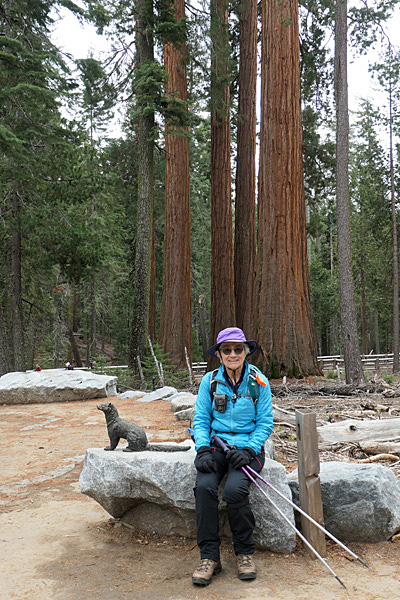 Debbie sitting next to Fisher statue. Sequoias in background. Debbie sitting next to Fisher statue. Sequoias in background.
|
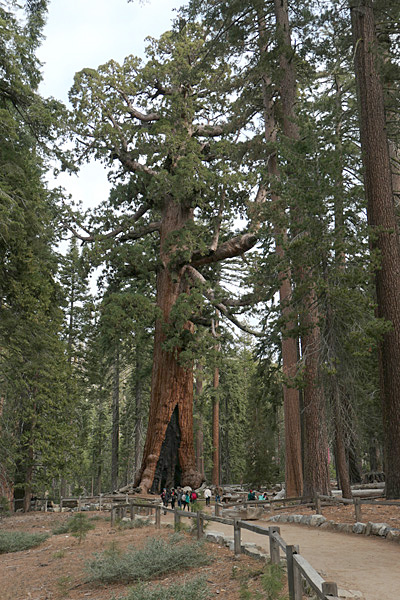 The Grizzly Giant The Grizzly Giant
|
Perhaps the most massive tree in the grove is the Grizzly Giant, estimated at over 2700 years old.
Just beyond the Grizzly Giant is the Tunnel Tree carved in 1895 for stagecoaches. We know better now. |
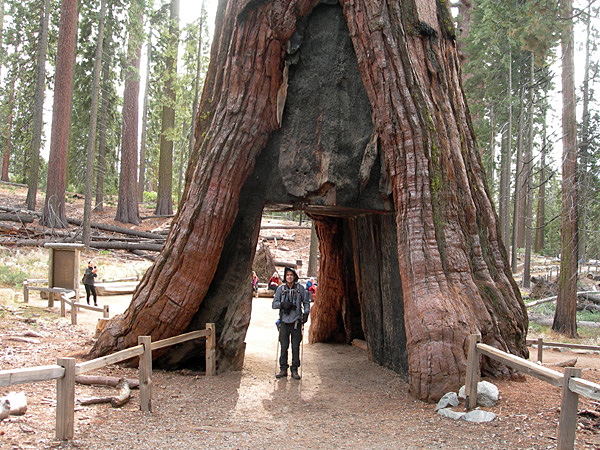 Richard at the Tunnel Tree. Richard at the Tunnel Tree.
|
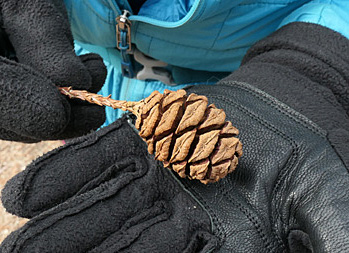 Sequoia cones contain about 200 seeds.. Sequoia cones contain about 200 seeds..
Beyond these two titans visitors thin out considerably as the distance to the parking lot from these trees is three miles making for a 6-mile round trip in winter. We continued on to Wawona Point and sights beyond making for an 11.5-mile hike with about 1600 feet of gain on well-developed trails.
The enormous sequoia trees spring like their cousin redwoods from a small seed. Sequoia cones are larger than redwood cones and contain about 200 seeds.
Even for folks like us living near redwood trees, these trees are awesome. In their presence one realizes just how small humans are. |
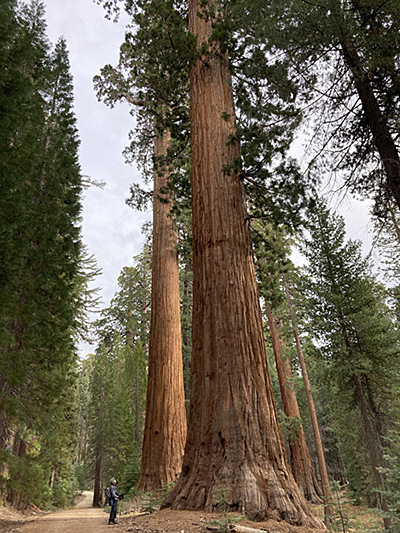 Richard gazing up at a Sequoia. Richard gazing up at a Sequoia.
|
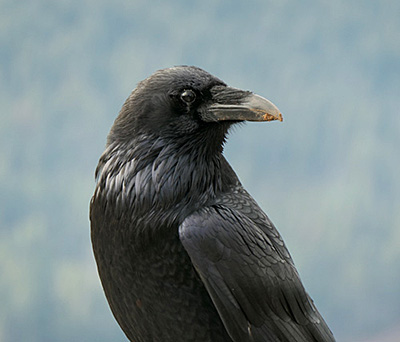 The route is replete with old roads and new cow paths. The route is replete with old roads and new cow paths.
We were greeted by a Raven when we reached Wawona Point.
This one had little fear of people and posed for a photo alongside us.
|
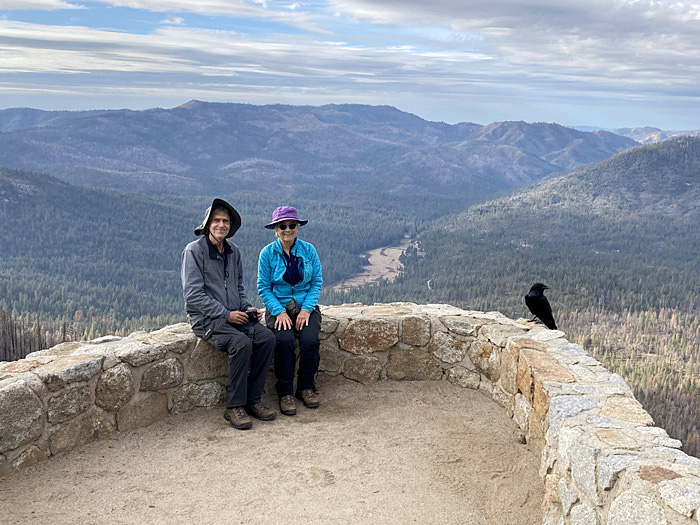 From Wawona Point we could almost see the cabin where we were staying. From Wawona Point we could almost see the cabin where we were staying.
|
The highlight of our hike was an up close view of a White-headed woodpecker dining on insects on a fused double-trunked tree called the Faithful Couple.
A moment to remember. |
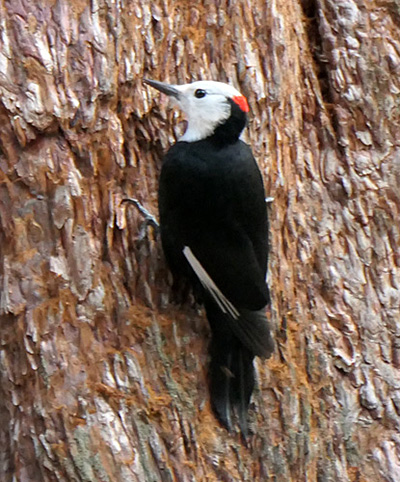 A male white-headed woodpecker. A male white-headed woodpecker.
|
|
President Biden Designates New National Monument Near Grand Canyon
Baaj Nwaavjo I’tah Kukveni—Ancestral Footprints of the Grand Canyon National Monument will honor tribal heritage and protect the area from uranium mining
August 2023
by Lindsey Botts
from Sierra: The Magazine of the Sierra Club
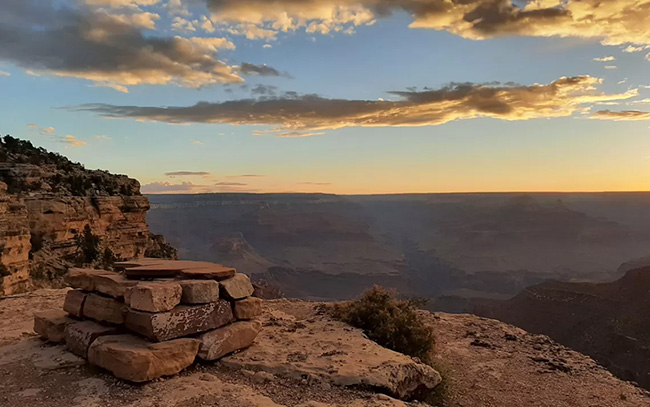 Photo by Nicole Segnini/NPS Photo by Nicole Segnini/NPS
Native American nations in the Southwest rejoiced on Tuesday when President Biden created a new national monument that protects federal lands surrounding Grand Canyon National Park. The new Baaj Nwaavjo I’tah Kukveni—Ancestral Footprints of the Grand Canyon National Monument will protect some 917,000 acres of federal land from new mining claims and will also bring added protections to thousands of Native American cultural sites in the area.
"Establishing the Baaj Nwaavjo I’tah Kukveni—Ancestral Footprints of the Grand Canyon National Monument honors our solemn promise to tribal nations to respect sovereignty, preserves America’s iconic landscapes for future generations, and advances my commitment to protect and conserve at least 30 percent of our nation’s land and waters by 2030,” Biden said in a statement Monday.
The presidential designation is the culmination of a decades-long push to create a national monument to preserve tribal heritage and protect vast swaths of the Colorado River watershed from uranium mining. While the gorge of the Grand Canyon and the mainstem of the Colorado River are protected by the national park, much of the surrounding lands have been open to commercial logging and uranium extraction.
Like Bears Ears National Monument in Utah, the new national monument will be comanaged with Native American tribes. Tribal members will be able to exercise their treaty rights, such as hunting, gathering, and practicing religious ceremonies. A dozen Native nations make up the Grand Canyon Tribal Coalition, which earlier this year called on President Biden to permanently protect the watershed around the Colorado River, a water source for nearly 40 million people. The coalition includes the Havasupai, Hopi and Navajo (or Dine), all of whom, along with other nations, consider the area where the monument is located part of their traditional homelands. The name of the monument is a combination of two Indigenous phrases: Baaj Nwaavjo, which means “where tribes roam” in Havasupai, and I’tah Kukveni, which means “our ancestral footprints” in Hopi.
"We have lived in and around the Grand Canyon since time immemorial. Our ancestors were once spread far and wide throughout the region," Havasupai Tribe vice chair Edmond Tilousi said in a statement earlier this year as the campaign for the national monument gained momentum. "Our home is still in the Grand Canyon.... The canyon is a part of each and every Havasupai person. It is our home, it is our land and our water source and our very being."
Read full article here.
Climate Change Impacts and Energy Challenges on the Central Coast of California - Let’s Take Action Now!
August, 2023
The central coast of California, a jewel of diverse landscapes, extensive biodiversity, and robust agriculture, is in the grip of the twin challenges presented by climate change and energy production. This region is experiencing a convergence of climate-related impacts and an urgent need to shift our rethink its energy infrastructure.
As a result of these impacts, the Chapter is interested in forming a Monterey County Climate and Energy change committee and is reaching out to members who wish to participate. There is some urgency that our local Sierra Club study changes in the areas we know well and look for solutions we can share with policy makers and a larger audience.
Among the most visible impacts of climate change are the increased frequency and severity of wildfires. Fueled by drier conditions, higher temperatures, and shifting precipitation patterns, wildfires are becoming an all-too-familiar threat. The impact of these blazes extends beyond environmental damage, causing smoky skies, hazardous air quality, and severe public health risks.
Simultaneously, water shortages and recurrent droughts pose an escalating challenge. Monterey County has several important rivers at overdraft levels. Combined with unpredictable rainfall, this threatens the region's water supply, impacting agriculture — a backbone of the state's economy. Considering California's position as one of the nation's leading agricultural producer, these implications reverberate far beyond the state borders.
The rise in sea levels, resulting from melting polar ice and warming oceans due to climate change, is another serious concern. Increased coastal erosion and flooding pose a risk to local infrastructure and agriculture production and could impact the flourishing tourism industry that sustains many coastal communities.
The region's biodiversity, too, is facing a precarious future. Changing temperatures and precipitation patterns are causing shifts in habitats and ecosystems. The effects range from altering bird migration patterns to endangering the health of marine life along the coast.
And, of course, the diverse people who live in our region are facing these impacts now – just look at the devastating flooding of Pajaro which caused extensive damage to homes and businesses and long evacuations and loss of belongings and jobs for the many farmworker families living there. Climate impacts are having a huge impact on low-income communities, who have the least resources to respond and recover.
However, amid these challenges lies many an opportunity — a transformation to clean energy, shifting our transportation system away from fossil fuels, building electrification, investing in our natural and working lands and less waste, all of which are well under way in California. The urgency of the climate crisis necessitates a swift transition away from fossil fuels towards renewable energy sources, a move that can alleviate some of the stress on the environment and present a sustainable future.
The central coast of California is uniquely positioned to lead this energy transformation. The region boasts abundant sunshine, making solar power a viable option and prevailing winds can be harnessed for wind energy. Advancements in battery technology and energy storage also allow for a more reliable supply of renewable energy, addressing concerns about the intermittent nature of wind and solar power.
Moreover, the transition to renewable energy is not just about power production — it's about consumption as well. Energy-efficient buildings, electric vehicles, and smart-grid technology can significantly reduce the demand for energy, contributing to a sustainable and resilient energy future for the region.
Despite these challenges, Monterey County is a beacon of climate action and innovation. Community resilience is at the forefront, with local residents, scientists, and policymakers implementing water conservation measures, fire management strategies, and investing in renewable energy and green infrastructure.
In conclusion, the challenges posed by climate change and energy production on the central coast of California are significant and multifaceted. Yet, they are not insurmountable. Monterey County has been working on a Climate Action and Adaptation Plan (for unincorporated areas) and many cities in the county have adopted or are working on local climate plans.
The timing is critical because substantial federal funding for clean energy investments is becoming available through the Inflation Reduction Act (IRA) and Infrastructure Investment and Jobs Act (IIJA) to help cities, businesses and residents afford clean energy, heat pumps and rooftop solar, EVs, chargers and more. We have the opportunity to advocate for through strategic planning, investment in sustainable practices, and building resilient communities that will not only combat these impacts but also lay the groundwork for a sustainable, energy-efficient and an equitable future. The potential for transformation is immense, and the time to act is now.
If you are interested in getting involved with this new Monterey County Climate and Energy committee, please RSVP or contact Kathy Dervin at:
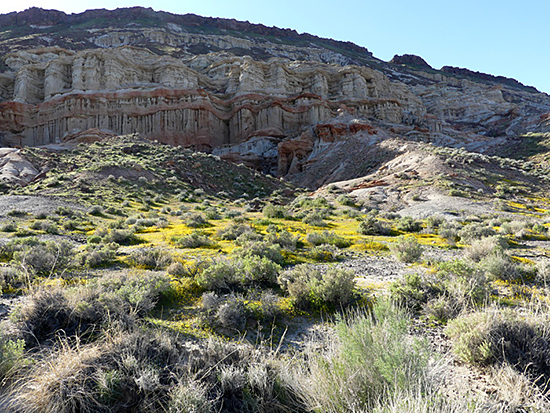 Goldfields at Red Rock Canyon State Park Goldfields at Red Rock Canyon State Park
It’s wildflower season after unusually heavy rains in California. Here are some stunning photos of flowers now blooming in the Mojave Desert by Richard Stover courtesy of Debbie Bulger. |
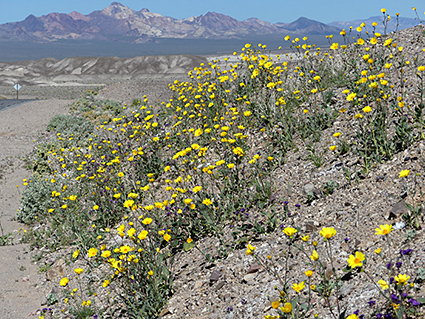 Desert Sunflowers Desert Sunflowers
|
 Desert Sunflower Desert Sunflower
|
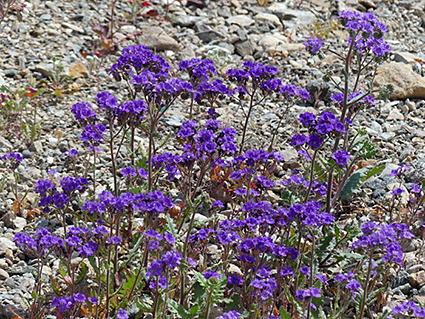 Notch-leaved Phacelia Notch-leaved Phacelia
|
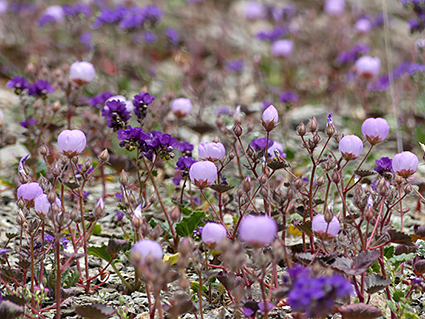 Desert Five-Spot and Notch-leaved Phacelia Desert Five-Spot and Notch-leaved Phacelia
|
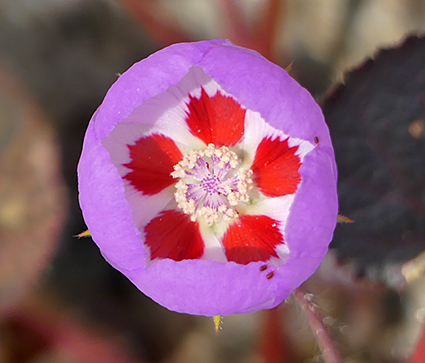 Desert Five-Spot Desert Five-Spot
|
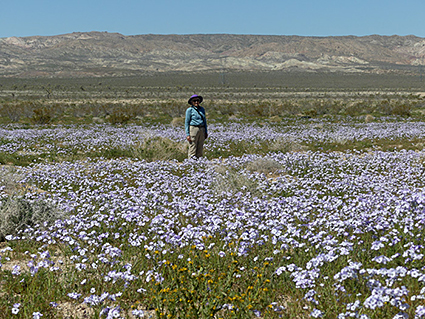 Broad-flowered Gilia Broad-flowered Gilia
|
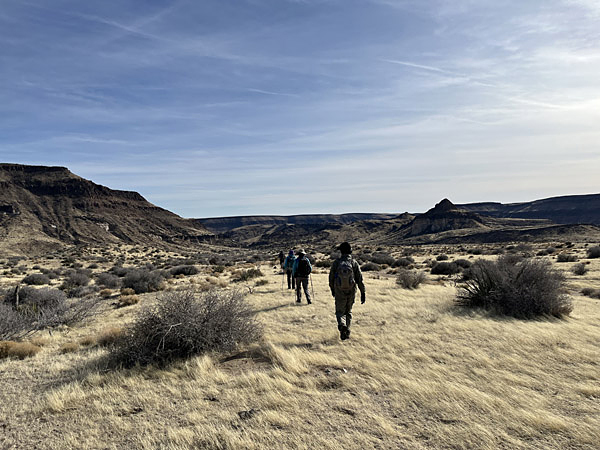 We were getting closer to Barber Peak (on left) We were getting closer to Barber Peak (on left)
Mid Hills to Hole-in-the-Wall
February 16, 2023
by Debbie Bulger
This classic hike in the Mojave National Preserve requires a car shuttle. Five of us, Richard, Debbie, Med, Carmelita, and Jackie, walked from the Mid Hills Campground after spending a cold, cold night (28 degrees!). We were on the trail for about six hours hiking the eight miles to Hole-in-the-Wall Campground.
Before the Hackberry Fire of 2005, the route descended through a high-country pinyon pine/juniper forest. Today the land is a long way from healing although most of the skeletons of the charred trees have decomposed. Grazing is slowing up recovery since the cows are chomping much of the new growth.
There was a bit of uphill at the start of the hike.
There is still much to savor about this trek. We were a bit early for wildflowers, but could see numerous emerging desert mallow which I understand blanket the hills in the spring. Since the paved Black Canyon Road was closed due to a washout, we used the 4WD Wild Horse Canyon road for the car shuttle which thankfully delayed our start until it warmed up a bit.
The trail starts off well defined and is marked by fiberglass posts, however, many are missing. Bring your map and compass or GPS. Additionally the route is criss-crossed by numerous cow paths and old dirt roads which can confuse the hiker. However, if you have even basic skill with map and compass, it is difficult to get lost. The route is generally south. To the east and west are roads, so if you think you might never see your family again, just head east or west, and you will hit a real road.
Along the way there are a few forest remnants and expansive views: To the east the volcanic mesa Table Mountain; to the south the interesting formations of Barber Peak. In all we dropped over 2000 feet and climbed 650 feet over rolling hills.
Approaching Hole-in-the-Wall we bypassed the narrows via a good trail on the west side of Barber Peak. As we dropped the last 400 feet through an unburned cactus garden, we could see our vehicle below.
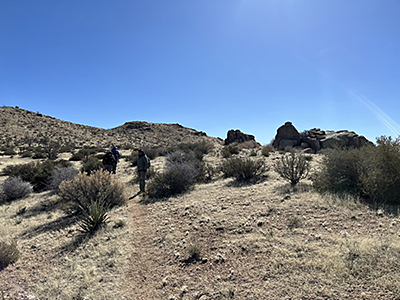 There was a bit of uphill at the start of the hike. There was a bit of uphill at the start of the hike.
|
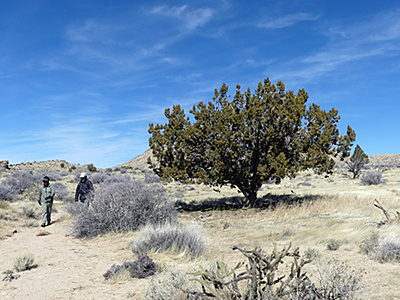 Along the way there are only a few trees that escaped the fire or have established since. Along the way there are only a few trees that escaped the fire or have established since.
|
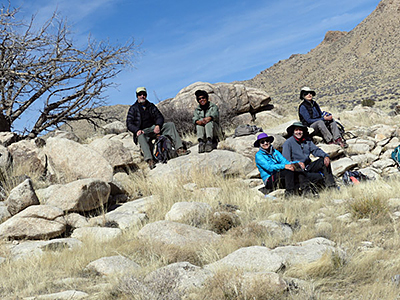 The five of us relaxing at lunch. The five of us relaxing at lunch.
|
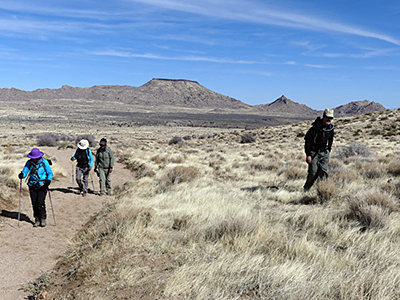 Table Mountain to the east. We had originally planned to climb Table, but the approach road was washed out. Table Mountain to the east. We had originally planned to climb Table, but the approach road was washed out.
|
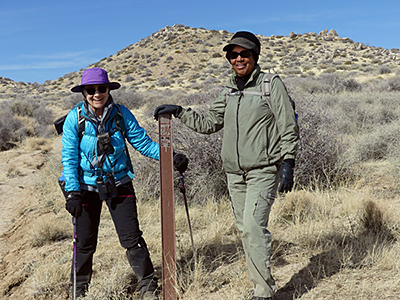 Debbie and Carmelita find a trail marker after not seeing one for several miles. Debbie and Carmelita find a trail marker after not seeing one for several miles.
|
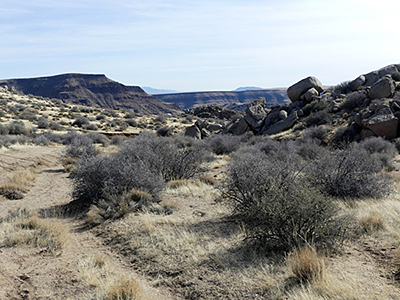 The route is replete with old roads and new cow paths. The route is replete with old roads and new cow paths.
|
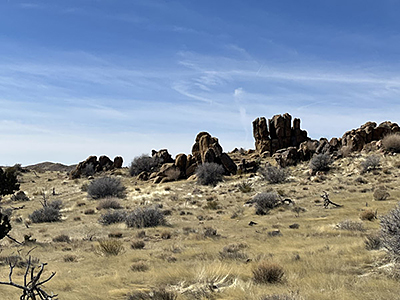 There were many interesting rock formations along the way. There were many interesting rock formations along the way.
|
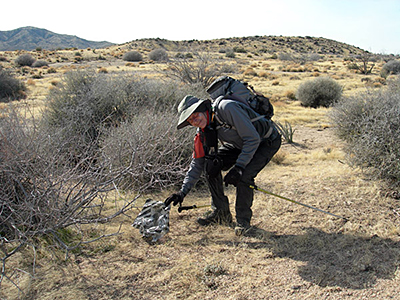 How many balloons are there in the wilderness? How many balloons are there in the wilderness?
|
 Looking down on the Narrows from the trail. Looking down on the Narrows from the trail.
|
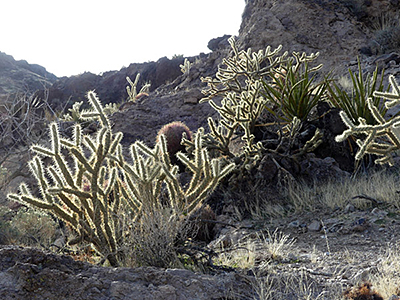 This beautiful cactus garden is on the well-defined trail about a half mile from our shuttle car. This beautiful cactus garden is on the well-defined trail about a half mile from our shuttle car.
|
Recent rains brought a rainbow over the hills in Boulder Creek.
(Photo by Ethan Quaranta)
Introducing the New Executive Director of the National Sierra Club, Ben Jealous
December 2022
 Photo by Christopher Jason Studios. Photo by Christopher Jason Studios.
The Board of Directors of the Sierra Club has voted unanimously in support of Ben Jealous, an experienced civil rights leader, community organizer, and coalition builder to be our new Executive Director. Ben’s passion for the outdoors and commitment to fighting for the environment, and his work leading People for the American Way and the National Association for the Advancement of Colored People (NAACP) – two of the nation’s most influential groups pursuing equity and justice and protecting democracy – makes him uniquely qualified to lead the Sierra Club at these intersections as our journey continues to create a healthy and sustainable planet for all.
From early in Ben’s life, he’s spent his time in nature and communities devoted to activism, from growing up in Pacific Grove, a neighborhood of oceanographers in California to summers spent with his grandparents during the civil rights movement in West Baltimore. The first protest Ben organized at school was against timber clear cutting. He worked as a journalist exposing “cancer clusters” in rural parts of Mississippi and was the youngest person to serve as president and CEO of the NAACP, which launched its climate justice program under his leadership.
Ben is now joining the most influential grassroots environmental organization at a critical juncture. Ben’s history and the Sierra Club’s role in the movement are coming together at a time that calls for bold, leadership to make sure there are never environmental sacrifice zones or disposable people living in them.
When Ben takes over his role with the Sierra Club on January 23, 2023, he will be the first person of color to lead the Sierra Club in its 130-year-old existence. This speaks to the meaningful moment we are in now, that now more than ever, we must work with communities who have been historically marginalized if we are to truly deliver on our mission to protect the planet for everyone. (Excerpted from an article by President of the Sierra Club Ramón Cruz).
Ventana Chapter Opposes Cal Am Proposed Desalination Plant in Marina Coastal Dunes at the California Coastal Commission
October 2022
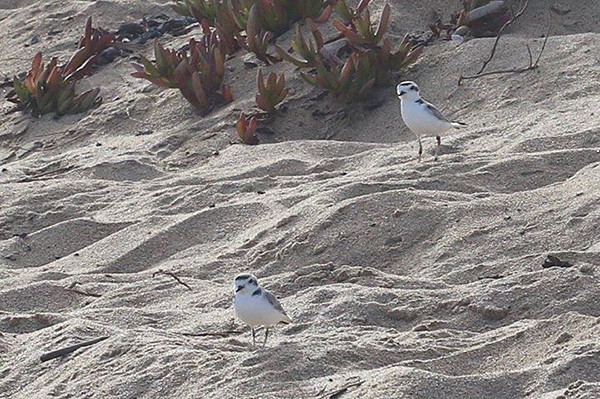 Threatened western snowy plovers in the Marina dunes. (Ventana Chapter file photo). Threatened western snowy plovers in the Marina dunes. (Ventana Chapter file photo).
On November 17 the California Coastal Commission (CCC) will meet in Salinas and on Zoom to hold a hearing on the proposed desalination plan plant proposed by Cal American Water. Cal Am, a private company with shareholders is the primary water purveyor for the Monterey Peninsula communities of Carmel, Pacific Grove, Seaside, Del Rey Oaks, Sand City, Carmel Valley, Carmel Highlands and Pebble Beach.
In early October, Cal Am released a description of a “phased approach” for the new desal plant which at first calls for building a 4.8 million-gallon-per-day facility on the soon to be shuttered Cemex plant in the coastal dunes in the City of Marina instead of any earlier proposal for a 6.4 million-gallon-per–day facility.
The signed Cemex Settlement agreement will now return those beaches and important sensitive habitats to the people for use as public access, low impact recreation and environmental protection. This was finally going to be a place where the residents of Marina and the Ord communities could go without expense to relax and enjoy the open spaces, coastal vistas within walking distance.
The negative impacts of a complex desalination plant at this site is an egregious example of poor land use and a violation of environmental justice. The Sierra Club has long held a position on environmental justice that when environmentally damaging projects are proposed, they should not be systematically placed only in communities of color and disadvantaged communities. All must share the pain associated with these projects.
For too long our society has engaged in systemic racial prejudice that manifests itself in many ways, one of which is to place these unwanted facilities in disadvantaged communities. This has the effect of sparing the financially well off, mostly white communities, from having to bear the effects of these projects. The City of Marina which has had to bear the brunt of almost all of these projects that benefit the Monterey Peninsula- a landfill, a wastewater treatment facility, a regional composting facility, an anaerobic digester facility and a sand mining operation that provided sand, gravel and cement for regional development. Marina also suffers from the adverse effects of leftover munitions and toxins from Fort Ord, a long established military installation that closed in 1994.
Marina formally adopted the Western Snowy Plover as their City shorebird because it symbolizes the environment and the need for protected places to be able to exist. If the Cal Am desalination project is allowed to be built, it will eliminate essential nesting habitat for the snowy plover and push the species one step closer to extinction. Public access will be impacted, recreational opportunity diminished and the beauty and potential views of serenity, open space and solitude will be lost for future generations.
In addition to threats to the federally threatened western snowy plover, many other rare and endangered coastal species that rely on the current Environmentally Sensitive Habitat Area (ESHA) will also be threatened. When the proposal was first officially proposed in 2020, the CCC staff report said the Project could result in up to about 35 acres of both temporary and permanent impacts to terrestrial ESHA during construction and operation, much of it to relatively rare coastal dune habitat.
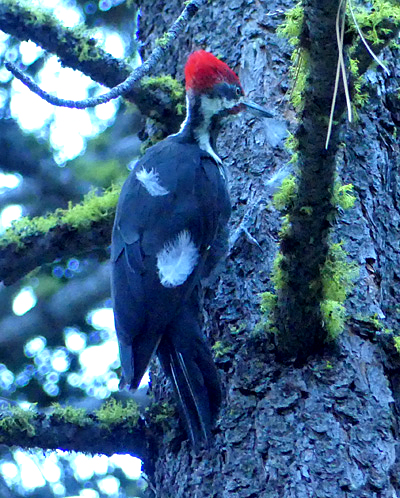 One of the two Piliated Woodpeckers we saw in Lassen NP One of the two Piliated Woodpeckers we saw in Lassen NP
Paulina Peak, 7984'
A Blast of a Birthday
October 2022
by Debbie Bulger
I chose to celebrate my 80th birthday with a blast from the past. That is, a volcanic excursion in Oregon and Northern California. Richard Stover and I began at Lassen National Park on our way to a celebration with family in Ashland, OR.
Imagine our elation as we watched not one, but two Piliated Woodpeckers drumming loudly at a pine near our Lassen NP campsite. Pieces of bark and feathers were flying. These large birds are a special treat to see and hear.
From our campground at Manzanita Lake we hiked to Crags Lake on the Chaos Crags Trail. After crossing a 10,000 – 15,000-year-old moraine we climbed two miles through a fir and pine forest past the Chaos Jumbles, an avalanche of rockfall from the adjacent steep Chaos Crags, eventually reaching the ridge above Crags Lake.
My guidebook from the 1980s predicted that this lake would be filled by rockfall by the “turn of the century.” Good call. No water—although I am told there is snowmelt there in the spring.
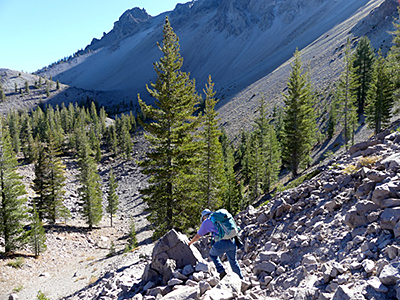 Debbie descending from the ridge to a dry Crags Lake. Debbie descending from the ridge to a dry Crags Lake.
|
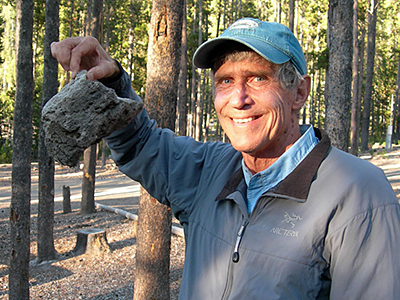 The rocks here are very light. The rocks here are very light.
|
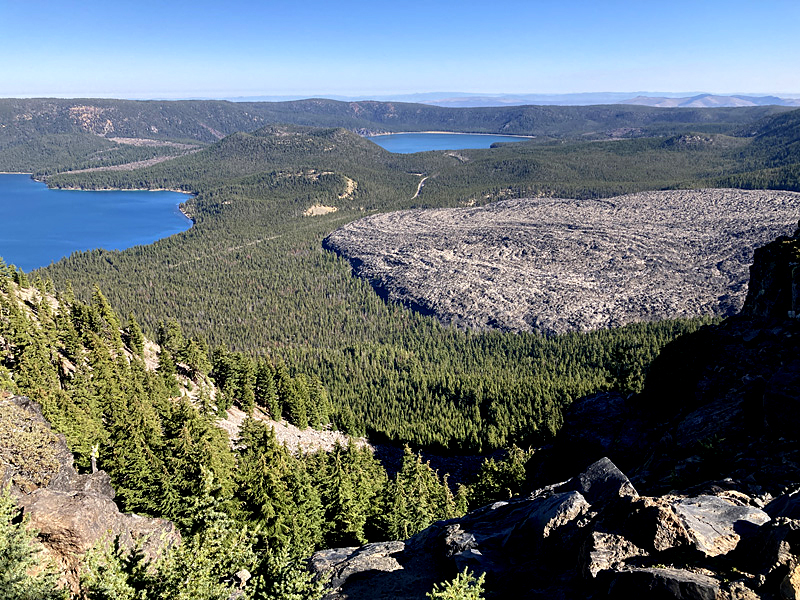 From the top of Paulina Peak one can see the Newberry Caldera containing Paulina Lake on the left and East Lake on the right. The flow lines of the Big Obsidian Flow are clearly visible from this viewpoint. The Central Pumice Cone is between the two lakes. From the top of Paulina Peak one can see the Newberry Caldera containing Paulina Lake on the left and East Lake on the right. The flow lines of the Big Obsidian Flow are clearly visible from this viewpoint. The Central Pumice Cone is between the two lakes.
After the family gathering in Ashland, our next stop on the volcanic tour was the Newberry National Volcanic Monument. This extraordinary place is a 6-mile-wide caldera filled with not one, but two crater lakes. Originally a single lake, East Lake and Paulina Lake were split by lava flows, one of which is the Big Obsidian Flow.
This square mile of volcanic glass poured out of the earth only 1300 years ago. It was an amazing short hike. Tourists are advised not to wear sandals, and dogs are not allowed on the trail because the sharp obsidian can cut feet. Informative signs along the way explain how and when the eruption occurred and how Native Americans used this valuable resource.
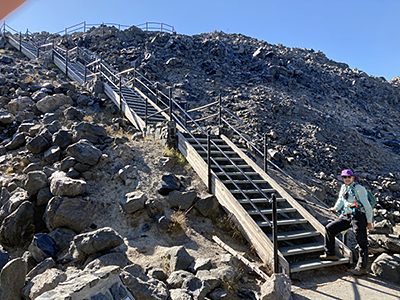 Stairs heading up Big Obsidian Flow Stairs heading up Big Obsidian Flow
|
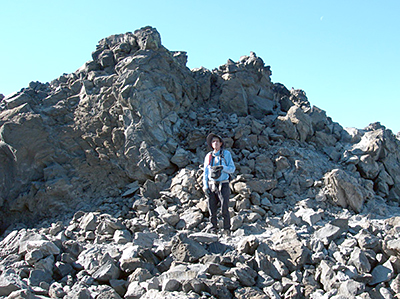 Richard walking among the chunks of obsidian and pumice. Richard walking among the chunks of obsidian and pumice.
|
 On the summit of Paulina Peak. Mt. Bachelor and South Sister on the left horizon. On the summit of Paulina Peak. Mt. Bachelor and South Sister on the left horizon.
We just had to climb Paulina Peak the next day for a birds eye view of the Big Obsidian Flow and glimpses of Mt. Bachelor and South Sister to the north. There is a well-graded 3-mile trail to the summit and a road for those who prefer to drive or bike.
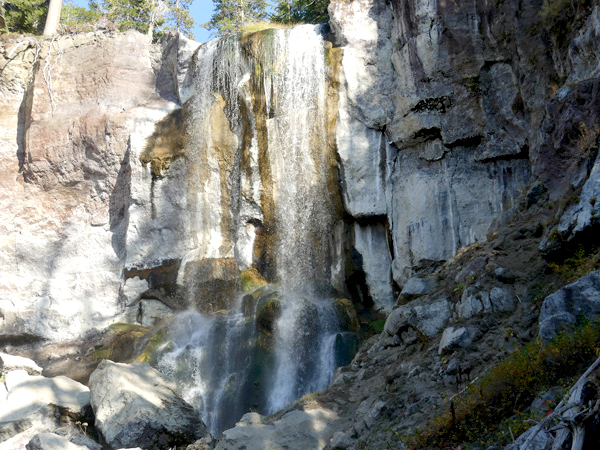 Paulina Falls. Paulina Falls.
Unfortunately mid-October is a bit late for camping at this National Monument. The rangers were busy closing up the campgrounds and covering all the signs in black plastic. We camped nearby in the national forest. Additionally, there was smoke starting to drift eastward from fires near Bend. After a short visit to Paulina Falls (reduced flow in the fall, but still wonderful) we returned the way we came on roads less travelled.
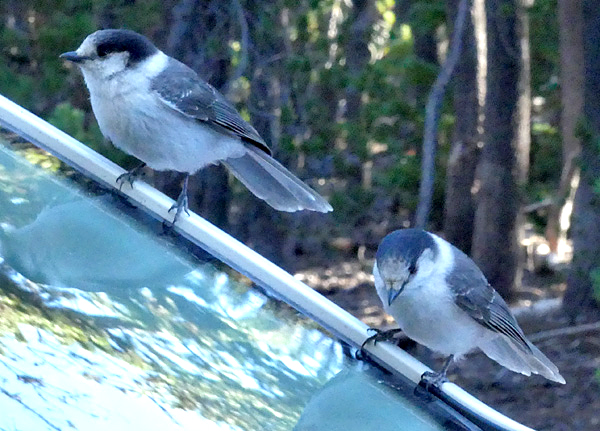 These bold Grey Jays swarmed our car to clean our windshield. These bold Grey Jays swarmed our car to clean our windshield.
As we briefly stopped on our way through the maze of mostly dirt/gravel roads in the surrounding national forest, Gray Jays descended on our car. They have learned that windshields are a great place to find lunch.
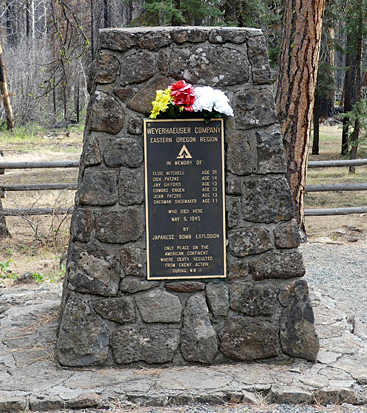 Mitchell Monument near Bly, OR Mitchell Monument near Bly, OR
|
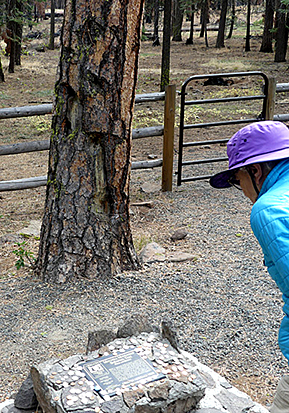 This Ponderosa Pine bears shrapnel scars from the explosion This Ponderosa Pine bears shrapnel scars from the explosion
|
Our meandering way home took us to Summer Lake Hot Springs and later the Mitchell Monument near Bly where six Americans were killed by a Japanese explosive device in May of 1945. Elsie Mitchell a Sunday School teacher and five of her pupils ages 11-14 were on a picnic when they gathered around a found object which exploded. It was a balloon-carried weapon borne by the jet stream at 30,000-40,000 feet and which had been designed by the Japanese to ignite forest fires in the Pacific Northwest in order to divert Americans from the war effort. A nearby tree still bears shrapnel scars.
Mrs. Mitchell had been pregnant with her first child. Her husband, a preacher, was parking the car when the bomb went off. In the 1980s, Yuzuru John Takeshita, a Japanese American who had been imprisoned at Tule Lake during the war learned about the incident on a visit to Japan from a woman who had been removed from high school during the war to work making the balloon bombs (called fugos) from paper and persimmon paste. Subsequent contact between the Japanese women and Oregon residents resulted in a rededication of the monument, gifted cherry trees for the site, and 1000 paper cranes to aid in healing.
A lesson in humanity for this writer born during the Second World War.
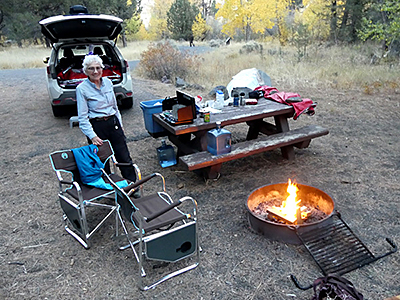 A beautiful campsite near Summer Lake Hot Springs. A beautiful campsite near Summer Lake Hot Springs.
|
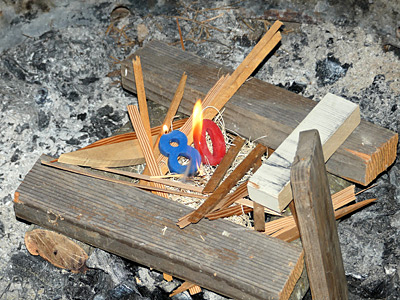 Candles make a great campfire starter. Candles make a great campfire starter.
|
Ventana Chapter Signs On to Letter to US Forest Service Requesting Extension of Comment Period for Proposed Forest Clearing Project
September 2022
The Forest Service has proposed a 235,000-acre logging and chaparral removal project in the Los Padres National Forest. This new proposal would allow the use of heavy equipment to cut trees up to two feet in diameter across 48,000 acres and trees of any size and age across an additional 186,000 acres. It would also allow mastication and activities to remove native shrubs across the entire project area.
The agency has stated they plan to prepare a single environmental assessment (EA) for the entire project. This would not involve site specific analyses for activities that would take place across the 368-square-mile project area in Monterey, San Luis Obispo and Santa Barbara Counties, nor would it involve public notice that activities are going to occur in this area once this single EA is approved. This letter requests that the USFS:
The U.S. Forest Service must prepare an EIS for the ERP before moving forward. The EIS should analyze several alternatives, including a significantly scaled-back version of the ERP that avoids sensitive and protected areas such as IRAs, proposed and potential Wilderness, critical biological zones, special interest management areas, research natural areas, and designated critical habitat for threatened and endangered species. In addition, the EIS should evaluate a much more strategically-targeted proposal that focuses on vegetation treatments adjacent to structures along with partnerships with local jurisdictions to encourage and promote home hardening, defensible space around homes, improved evacuation routes, and human-caused ignition reduction on private and public lands.
These actions will ensure that the public and local experts have adequate time to weigh in with concerns and relevant information.
Ventana Chapter, along with other Sierra Club Chapters and allies has signed on to the full letter here.
Goddard Canyon
June 28 - July 5, 2022
By Debbie Bulger
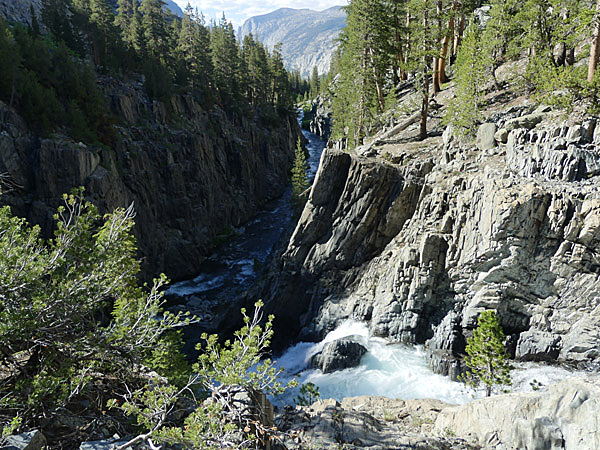 Scenic and biologically diverse, Work Memorial Park in The sheer walls of Goddard Canyon drop down to the South Fork of the San Joaquin River. (photo Richard Stover). Scenic and biologically diverse, Work Memorial Park in The sheer walls of Goddard Canyon drop down to the South Fork of the San Joaquin River. (photo Richard Stover).
Goddard Canyon is located between the John Muir Trail (JMT) and Martha Lake in Kings Canyon National Park. Its sculptor, the South Fork of the San Joaquin River, has carved a deep gorge with sheer walls dropping 50 feet to the river in some places.
From the Martha Lake outlet it flows north to the JMT then west for almost 50 miles growing in volume from tributaries until it reaches Florence Lake. Beyond that it continues to the Central Valley where it intermittently runs dry due to overzealous diversions until it finally joins the Sacramento River emptying into Suisun Bay and ultimately the Pacific Ocean.
Richard Stover and I were originally bound for Peter Peak where we planned to scatter my brother Peter’s ashes. The river gods had other plans.
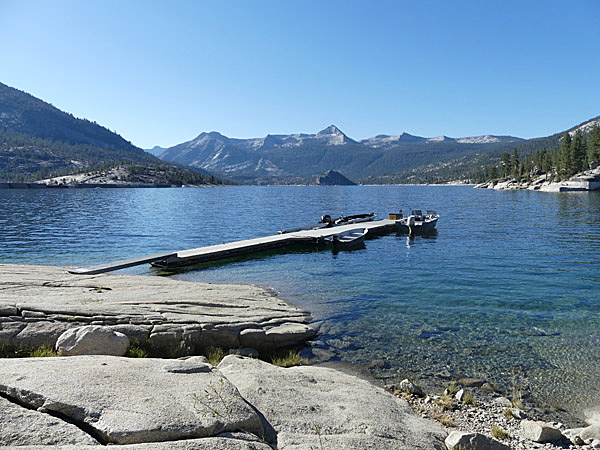 Florence Lake Ferry landing with pointed Mt. Shinn on center horizon across the lake. (photo Richard Stover). Florence Lake Ferry landing with pointed Mt. Shinn on center horizon across the lake. (photo Richard Stover).
Having spent the night in the back of our car in the backpackers parking lot, we took the 9:30 a.m. ferry across Florence Lake. Our boat captain, Estella, was the source of good information about the lake, local resources, and the Muir Trail Ranch where she had previously worked.
The road to Florence Lake is much deteriorated partly due to heavy equipment use during the Creek Fire in 2020. Thankfully, the area where we were headed had seen no recent fires.
It’s about 11.5 miles from the ferry landing to the junction of the Goddard Canyon Trail. Along the way we met many Pacific Crest Trail and John Muir Trail hikers. These hikers (mostly young) all seemed to wear electronic tracking devices which let the folks at home know their whereabouts. Additionally many were constantly checking their cell phones on which were digital maps of the trail complete with GPS locators pointing to their location. Fortunately for them, the Muir Trail Ranch where they resupply now has electronic charging outlets!
Other backpackers became scarce after Richard and I turned south on the Goddard Canyon Trail. Indeed over the more than three days we spent in Goddard, we saw only three other parties. Visitors are so few that at least this year flowers were growing in the trail itself.
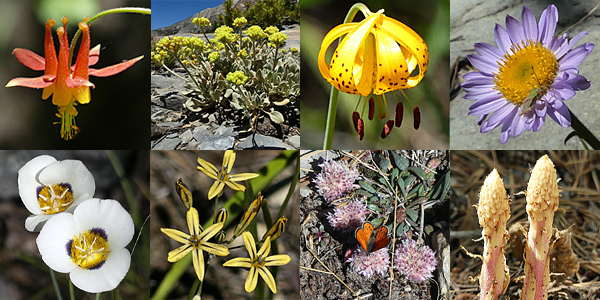 Click Photo for larger image. Click Photo for larger image.
From top left: Crimson Columbine, Hoary Buckwheat, Leopard Lily, Wandering Lily, Mariposa Lily, Pretty Face Brodia, Pussy Paws, Fringed Pinesap
(photos Richard Stover).
Did I say “flowers?” I meant to say FLOWERS!!!! This is a banner year due to late season rains. Flowers in every habitat. Flowers of every color, shape and size. Some I had never seen before. So many that I don’t have room for all their photos in this report. To name a few: Sierra wallflower, Crimson Columbine, Leopard lily, Alpine paintbrush, Stonecrop, Pretty Face brodia, Swamp onion, Wandering Daisy, Arnica, Pink Alumroot, Penstemon, Pussy Paws. Two plants I had never identified before were the Fringed Pinesap and the unobtrusive Green Raillardella which I had seen before, but not looked up.
As we hiked up Goddard Canyon, our navigational skills were put to the test since we had decided not to bring our GPS on this trip to reduce weight. I counted drainages as we travelled up canyon as well as studied landforms. We were looking for North Goddard Creek which empties into the South Fork of the San Joaquin River where we wanted to cross the river to reach Peter Peak. There was one waterfall indicated on the map, but we observed several others, one almost as high as the marked one.
The high walls on either side of the canyon sported numerous cascades dropping hundreds of feet and spilling into the river below. |
Sometimes the water flowed onto the trail making hiking more interesting. |
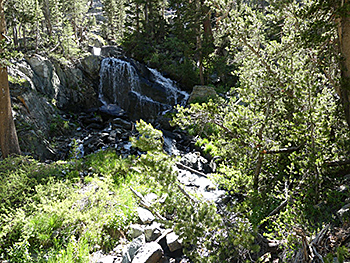 One of the side tributaries cascading down the canyon. (photo Richard Stover). One of the side tributaries cascading down the canyon. (photo Richard Stover).
|
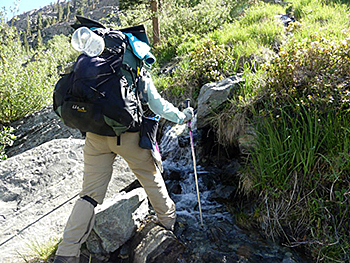 Water from a tributary flowing on the trail. (photo Richard Stover). Water from a tributary flowing on the trail. (photo Richard Stover).
|

This is the highest waterfall which was marked on the topo map. (photo Richard Stover).
|
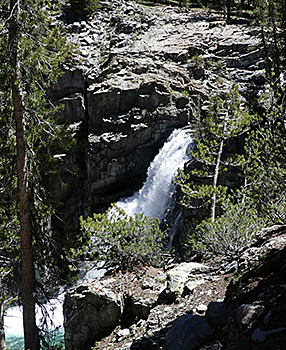 This waterfall was just below our camp. (photo Richard Stover). This waterfall was just below our camp. (photo Richard Stover).
|
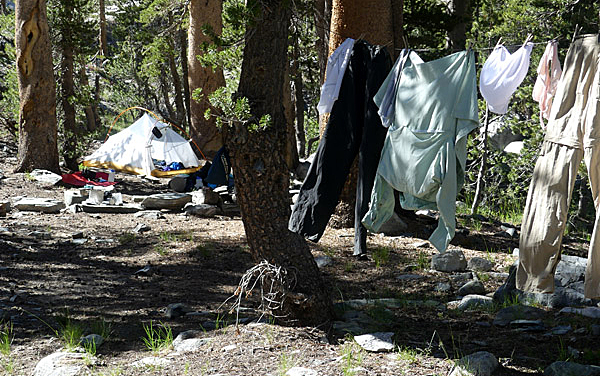 Our camp.
(photo Richard Stover). Our camp.
(photo Richard Stover).
Although the map shows the trail as next to the river, most of the time it is actually about 40-50 feet above the river on the rim of the gorge. Campsites are located in the few spots where the trail approaches the river.
We settled in to a perfect campsite very near where we hoped to cross. It was flat and expansive just above the second-highest waterfall and came complete with bear claw territory scratches on the lodgepole pine near where we set up our tent.
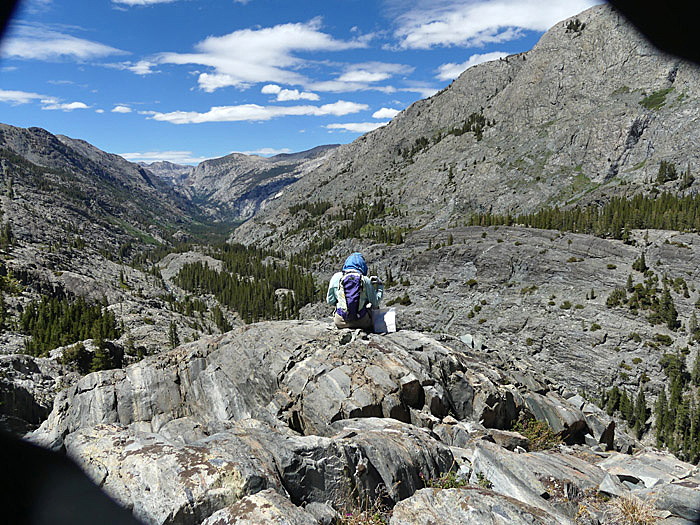 On one of our layover days we hiked above the canyon looking for the remains of the Hell for Sure Trail.
(photo Richard Stover). On one of our layover days we hiked above the canyon looking for the remains of the Hell for Sure Trail.
(photo Richard Stover).
There was no question about our crossing the river near there. It was at peak flow and fast. When we rinsed out our dusty clothes, we had to hold on to them tightly so they wouldn’t break away from our grips and plummet over the falls. Crossing the South Folk was too dangerous for us. Peter Peak was out.
We spent the next two and a half days resting and scouting the area. We located the almost obscured intersection with the no-longer-existing Hell for Sure Trail which I hiked on my approach to Mount Goddard in 1984. It was hard to find in places even at that time. Today it is pretty much obliterated.
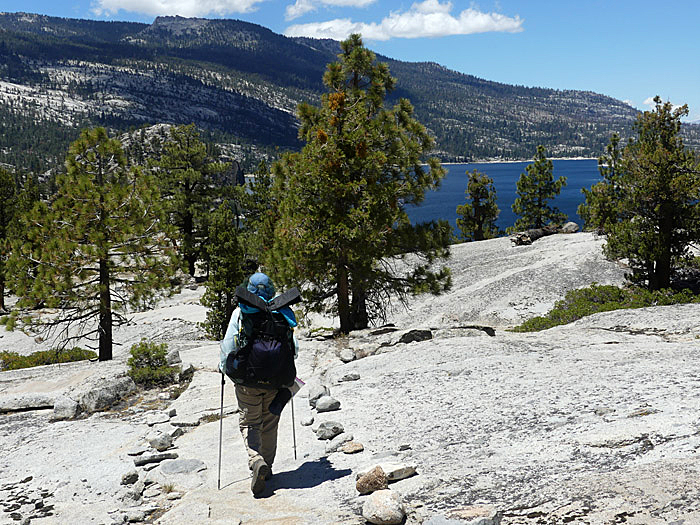 Returning to Florence Lake.
(photo Richard Stover). Returning to Florence Lake.
(photo Richard Stover).
We hiked almost to Martha Lake for outstanding views both up and down canyon. There in a glorious spot in view of both Peter Peak and Mount Reinstein I released some of the ashes of my brother Peter who had died in November. A fitting resting spot for a fellow climber.
Over the next three days we hiked the 20 miles back to the ferry landing thoroughly renewed by our time in this beautiful canyon.
2022 Celebrates the 130th Anniversary of the Sierra Club
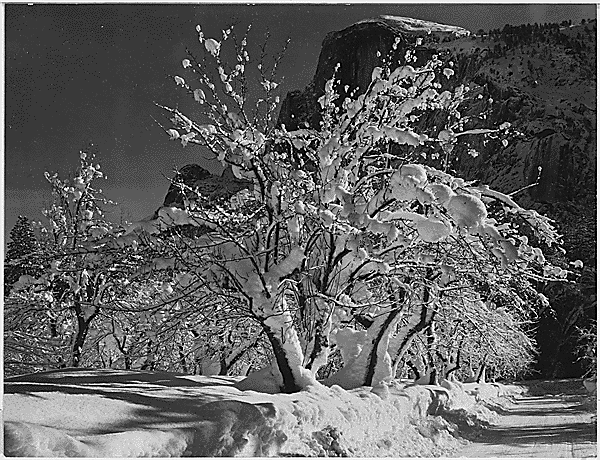 Trees with Snow on Branches, "Half Dome, Apple Orchard, Yosemite,” California by Ansel Adams, founder of Ventana Chapter Sierra Club in 1963. (Photo courtesy of the US National Archives and Records Administration). Trees with Snow on Branches, "Half Dome, Apple Orchard, Yosemite,” California by Ansel Adams, founder of Ventana Chapter Sierra Club in 1963. (Photo courtesy of the US National Archives and Records Administration).
1890s The Sierra Club is founded on May 28, 1892, with John Muir as its first president. It quickly mobilizes to defeat a proposal to reduce the boundaries of Yosemite National Park. The Sierra Club urges strengthening of public forest policy and supports the creation of new national parks, including Grand Canyon.
1900s The Sierra Club begins an organized outings program, with annual trips to the Sierra Nevada. President Theodore Roosevelt visits Yosemite National Park with John Muir and, two years later, the Sierra Club’s campaign to return management of Yosemite Valley to the federal government from the State of California succeeds.
1910s The National Park Service is created, with Stephen Mather, a Sierra Club member, as its first director. The California legislature passes a law to support construction of the John Muir Trail in the Sierra Nevada.
1920s Sequoia National Park is expanded, and the Sierra Club successfully opposes dam sites in the Kings River region. Aurelia Squire Harwood becomes the first woman to serve as the Sierra Club’s president.
1930s Sierra Club members introduce modern rock-climbing techniques to the US. Photographer Ansel Adams visits Washington, D.C., to lobby Congress and the president to preserve Kings Canyon. The 210-mile John Muir Trail is completed.
1940s Kings Canyon National Park is established. The Sierra Club opposes an attempt to repeal the Antiquities Act, which is used to establish national monuments. The Sierra Club successfully defeats proposed dams in Kings Canyon and Glacier National Parks. During World War II, many Club members use their backcountry skiing and mountaineering skills in the US Army’s 10th Mountain Division.
1950s Grand Teton National Park and Olympic National Park are enlarged at the Sierra Club’s urging. A long but ultimately successful campaign stops dam construction in Dinosaur National Monument. The Sierra Club organizes its first volunteer-service outings.
1960s The landmark Wilderness Act is passed by Congress after a long campaign by the Sierra Club and others, marking the first time that public lands (9.1 million acres) are permanently protected from development. The Sierra Club also mobilizes public opinion to stop two dams in the Grand Canyon. But the cost of victory was high: Decision-makers chose to power the flow of water to the Southwest by building a massive coal-fired power plant on Navajo land. For more than four decades, the plant exposed members of the Navajo Nation to unacceptably high levels of air pollution. According to the Clean Air Task force, the plan caused an estimated 16 premature deaths, 25 heart attacks, 300 asthma attacks, and 15 asthma emergency room visits every year it operated.
1970s The Sierra Club helps organize the first Earth Day. Efforts of the Sierra Club and others—including Black community organizers who fought against destructive “urban renewal” projects—lead to passage of the National Environmental Policy Act and the Water Pollution Control Act. The Sierra Club also joins a successful effort to strengthen the Clean Air Act and works to pass the Endangered American Wilderness Act, which protects 1.3 million acres.
1980s A decade-long Sierra Club campaign leads to passage of the Alaska National Interest Lands Conservation Act—the largest land and water protection legislation in history. It instantly doubles the size of the national park system and protects more than 157 million acres of public lands in Alaska. The Sierra Club helps defeat Reagan administration attacks on the Clean Air Act and other environmental laws. The Sierra Club forms a political committee and makes its first electoral endorsements.
1990s The Sierra Club leads a grassroots effort to reauthorize the Clean Air Act and successfully lobbies Congress to pass the California Desert Protection Act, which establishes 7.6 million acres of new desert wilderness and expands both Death Valley and Joshua Tree National Parks. The Sierra Student Coalition is organized. The Sierra Club forms an Environmental Justice program to address the disproportionate environmental burdens on low-income communities and communities of color.
2000s The Sierra Club defeats a plan to allow commercial logging in Giant Sequoia National Monument and stops the construction of 170 proposed new coal-fired power plants. The Sierra Club successfully advocates for the Omnibus Public Land Management Act—the largest public-lands conservation effort in 20 years.
2010s The Sierra Club works with President Obama to protect more than 4 million acres of public lands. The Sierra Club’s Beyond Coal campaign becomes the most successful environmental initiative in history and is complemented by the Ready For 100 campaign, which encourages more than 100 US municipalities to formally commit to transition to 100% clean, renewable energy for generating electricity.
Monarch Butterfly Numbers Are on the Rise Locally and in Mexico
June, 2022
Some good news this year is that various press outlets both nationally and locally are reporting an increase in Monarch butterflies in several locations. The Monterey Herald reported earlier this year that volunteer community scientists recorded about 14,000 butterflies at the Pacific Grove Monarch Butterfly Sanctuary in November 2021, according to Natalie Johnston, the volunteer and community science coordinator of the Pacific Grove Museum of Natural History. There were no recorded butterfly clusters in 2020 so this was quite a rebound.
On May 25 Associated Press reported a 35 percent increase in Monarch butterflies arriving this year in the protected areas in the forested mountaintops of Mexico. Their annual butterfly count does not count the number of butterflies but rather the number of acres they cover. Last year’s acreage was 5.2 acres and this year it was 7 acres.
Positive Steps Happening Now in the Arctic National Wildlife Refuge
June, 2022
Published by Clayton Daughenbaugh for the Sierra Club National Wilderness Committee
We've had a series of big developments in the campaign to protect the Arctic National Wildlife Refuge that are worth celebrating.
In the last two weeks, all oil companies that held leases within the boundary of the Refuge have withdrawn their lease agreements. Chevron and Hillcorps held leases through the Arctic Slope Regional Corporation (ASRC) and actually paid 10 million dollars to exit their arrangement. They acquired the leases on ASRC land from a historic deal that would have allowed them to develop them when drilling proceeded on the federal lands in the coastal plain. Keep in mind that the federal lease sale held in 2020 by the Trump administration only brought in 12 million dollars, meaning that these companies paid almost as much to get out as was generated in a lease sale. Then, just last week, 88 Energy withdrew their federal leases which they acquired during the Trump lease sale. 88 Energy was the only oil company to lease exploration rights in 2020, with the rest of the leases bought by either the State of Alaska or a small real estate speculator.
Why are oil companies leaving when oil is reaching historic high prices? We have brought a tremendous amount of pressure to bear. Over the last three years, this campaign has focused on corporate work aimed at cutting off essential finance and insurance to the industry in the refuge, while at the same time forcing the administration to publish a supplemental environmental impact statement via advocacy and smart, strategic litigation. In addition, we have also effectively advocated for revoking the leasing program in the halls of congress. We've sent a clear message that along with our partners; we will stop them on every axis.
Furthermore, we secured a new commitment from a major international insurance company to exclude underwriting or bonding for oil and gas companies drilling in the Arctic Refuge. Sompo joined 13 other companies in making this commitment, amplifying the pressure we are already putting on American insurers. This announcement came on the heels of a campaign arch of phone calls, emails, and an in person rally at the headquarters of Travelers insurance during their Annual General Meeting (AGM). We also directed the same pressure, minus the in person action, at The Hartford during their AGM. Each insurer we remove from the board means one less place for oil companies to turn to get required insurance. For the rest of this year, we'll continue to escalate with American insurers until we have taken all of their options away from oil developers. This should help influence any future lease sales and to remove opposition from a legislative or administrative solution.
This team has done a tremendous job both as a stand alone and in collaboration with our partners.
Chapter Support For Protection of Work Memorial Park in Del Rey Oaks
May, 2022
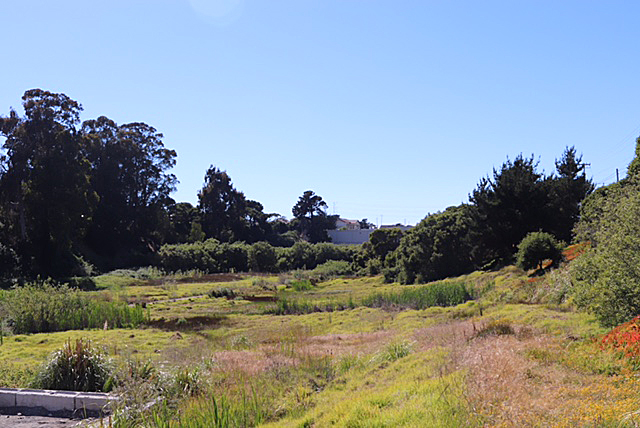 Scenic and biologically diverse, Work Memorial Park in Del Rey Oaks needs protection from planned construction in the nearby areas of the former Fort Ord, urban and airport runoff and the commercial use of Work Memorial Park for large truck traffic. Scenic and biologically diverse, Work Memorial Park in Del Rey Oaks needs protection from planned construction in the nearby areas of the former Fort Ord, urban and airport runoff and the commercial use of Work Memorial Park for large truck traffic.
(Ventana Chapter file photo).
Work Memorial Park is one of the three large parks in Del Rey Oaks and the location for significant federally recognized wetlands. Upstream, it is connected by the Arroyo Del Rey stream to the Frog Pond Preserve (part of Monterey Peninsula Regional Park District) and the “17 acres” wetland area just east of General Jim Moore Blvd. Downstream, Work Memorial Park waters flow into Laguna Grande Regional Park, Roberts Lake, and finally into the Monterey Bay National Marine Sanctuary. Work Memorial and the 17 acre wetland areas are important and sensitive habitats that represents two of the last natural drainages in the cities of Seaside, Del Rey Oaks, and Monterey.
Unfortunately, Work Memorial Park and the Arroyo Del Rey watershed are under many threats. The runoff from Hwy 68 and 218, the planned construction in the nearby areas of the former Fort Ord, the urban and airport runoff, and the commercial use of Work Memorial Park for large truck traffic are just a few.
Sustainable Del Rey Oaks (SDRO) contacted the Chapter and brought this to our attention. What was needed was a professionally conducted wetland delineation and habitat assessment to understand what habitats and species are present, the current health of these habitats, and what our paths forward may be to protect and restore these wetlands. These studies are woefully lacking in many areas of our County and yet, without them, it is difficult to bring the credibility and pressure needed to ensure that sensitive habitats are protected when development projects are proposed.
The Chapter retained The Biotic Resources Group, a local environmental assessment firm to conduct a study. The scope of work included a wetland delineation (federal standard) and habitat assessment of the study area (Work Memorial Park, Arroyo del Rey, and the 17-Acre Parcel). The habitat assessment tasks included mapping plant community types, identifying occurrences of invasive, non-native plant species, and documenting sensitive species and/or habitat.
The assessment has been completed and the overview states the Biotic Resource Group conducted a formal wetland evaluation and reported their findings in two complementary documents. The SDRO Arroyo Del Rey and Work Memorial Park Study Delineation of Jurisdictional Federal Waters (Delineation) follows the US Army Corp of Engineers format; whereas the SDRO Arroyo Del Rey and Work Memorial Study Baseline Report (Baseline) is more expansive, including descriptions of plant communities, threatened and invasive, and recommendations for habitat management. The 54.9 acres studied includes Work Memorial Park, the Arroyo Del Rey stream itself, the “17 Acres” parcel, and to a lesser degree, the Frog Pond Preserve. The study identified 10.162 acres of wetland habitat, as well as 9 different sensitive plant habitats. It also identified 21 non-native invasive plants.
Shuttered Cemex Site in Marina Now Under Negotiations for Future Use as Public Coastal Acreage
 Current Cemex plant now in the process of being repurposed as public land. Current Cemex plant now in the process of being repurposed as public land.
By Kathy Biala
May, 2022
On Dec. 31, 2017 the CA Coastal Commission, along with the State Lands Commission and the City of Marina approved a settlement agreement with Cemex, that would end the last active sandmining operation on any U.S. shore. This agreement requires Cemex to sell the property, at a reduced purchase price, to a non-profit or governmental entity approved by the Commission for conservation, public access and low impact recreation in perpetuity. This was a historic moment.
Per the agreement, all sand extraction has ceased as of Dec. 31, 2020 and now the last sales of the remaining stockpiles of sand on the property will occur and the remaining staff will be transitioned out. The agreement requires a restoration plan be completed in three years from the cessation of the sandmining operations (by 2023).
However, this Cemex property remains a site of concern for the public, as the proposed CalAm slant well desalination project is planned on this very same property, with several large well head structures on the near foredunes and pipes traversing the property. A legal easement to do so was established by CalAm and Cemex several years ago.
The CA Coastal Commission has twice recommended denial of the CalAm project on environmental and environmental justice issues; CalAm withdrew their application the night before the second and final hearing on the project. The current reapplication has been deemed incomplete by the CCC, and further hearing on the project has been stalled as a result.
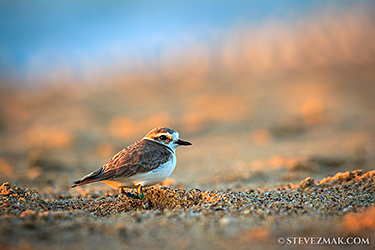 Protecting populations of threatened western snowy plovers at the Cemex site and along the Central Coast beaches are a priority for Ventana Chapter. Protecting populations of threatened western snowy plovers at the Cemex site and along the Central Coast beaches are a priority for Ventana Chapter.
The elements of the Cemex Settlement Agreement are not affected by the outcomes of the CalAm desalination project. The Coastal Commission staff report continued compliance with all aspects of the agreement; the land restoration plan is currently being reviewed by the CCC and other required agencies, and restoration activities will be overseen by the CCC. Full restoration will likely continue beyond 2023. Ventana Chapter has a mitigation fund of hundreds of thousands of dollars that could be used towards restoration.
The Cemex site is to be sold to public agencies and negotiations are now occurring. The coastal property site that is under the Settlement Agreement is approximately 100 acres and will soon become a publicly owned, protected natural environment for threatened and endangered species to thrive. This will also contribute to further beach access points to residents of Marina and tourists to experience and enjoy pristine coastline habitats.
U. S. Senate Committee Unveils Historic Outdoor Recreation Package
By Ian Brickey
May 3, 2022
Park Funding Measures Will Boost Community Health, Help Tackle Climate Change
WASHINGTON, D.C. -- Today, the Senate Energy and Natural Resources Committee began its mark-up of a major outdoor recreation legislative package, which includes the Outdoors for All Act. If passed, the Outdoors for All Act would permanently authorize the Outdoor Recreation Legacy Partnership (ORLP) program, which is the only program administered by the Department of the Interior to promote the development of equity-focused parks and green space projects in urban communities. The committee is expected to send the bill to the full House in the coming days.
Multiple studies show that nearby access to parks and green and natural spaces increases community health outcomes while boosting local economies and helping achieve the goal of protecting 30% of lands and waters by 2030 necessary to stop the most damaging effects of climate change.
In response, Jackie Ostfeld, director of Sierra Club’s Outdoors for All Campaign, released the following statement:
“Parks and green spaces make our communities more resilient. They offer clean air, provide shade to cool neighborhoods, and allow all people, regardless of age, race, or privilege, to make a direct connection with nature. As we face a national mental health crisis and the increasingly devastating effects of the climate crisis, the mental and physical health benefits of nature are more critical than ever. Passing the Outdoors for All Act will allow more communities across the country, especially in urban areas, to finally enjoy the benefits only these natural places can provide, while helping build up the green infrastructure we need to take on climate change.”
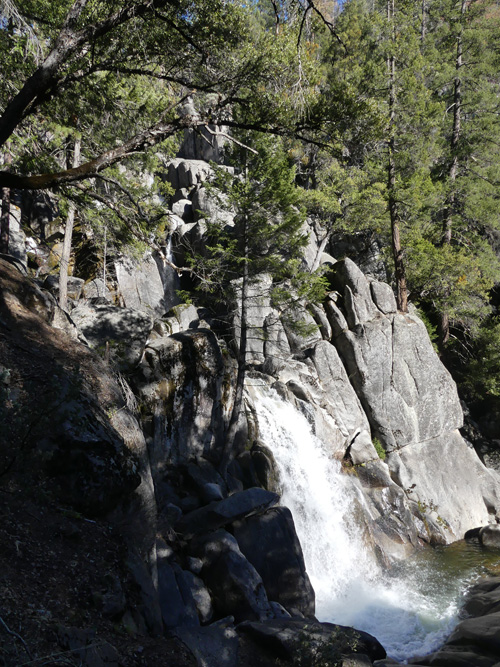 Lower Chilnualna Falls Photo by Richard Stover Lower Chilnualna Falls Photo by Richard Stover
Chilnualna Falls
By Debbie Bulger
February, 2022
One of my favorite Wawona-area hikes in Yosemite National Park is Chilnualna Falls. During a rest day between two snow tours, Richard Stover and I visited the lower falls. The longer hike to the upper falls is a full day affair which we have done in the past.
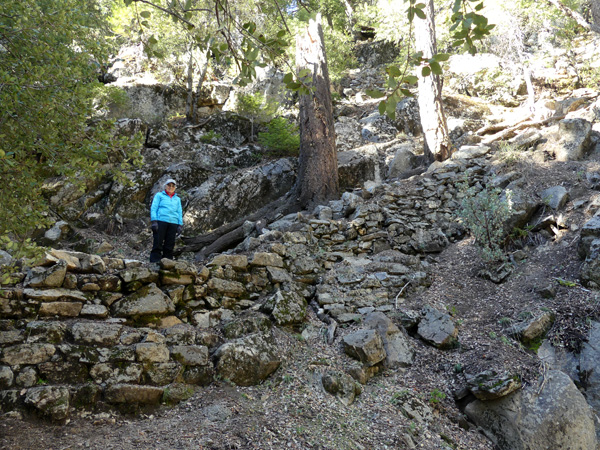 The lower part of the trail has a lot of rockwork. Photo by Richard Stover The lower part of the trail has a lot of rockwork. Photo by Richard Stover
The highlight for me is the careful rockwork including several “staircases in the sky” on the lower portion of the trail.
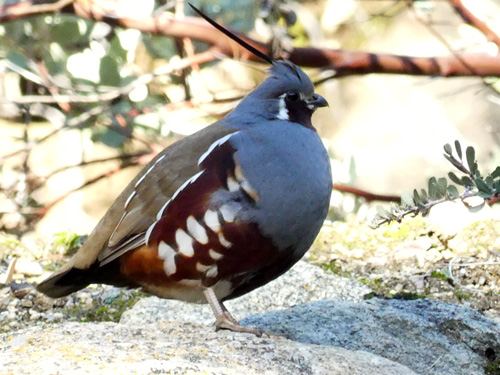 Mountain Quail have straight topknots instead of the comma-shaped ones of our local quail.. Mountain Quail have straight topknots instead of the comma-shaped ones of our local quail..
Photo by Richard Stover
A bonus on our way back was a covey of Mountain Quail with their straight topknots.
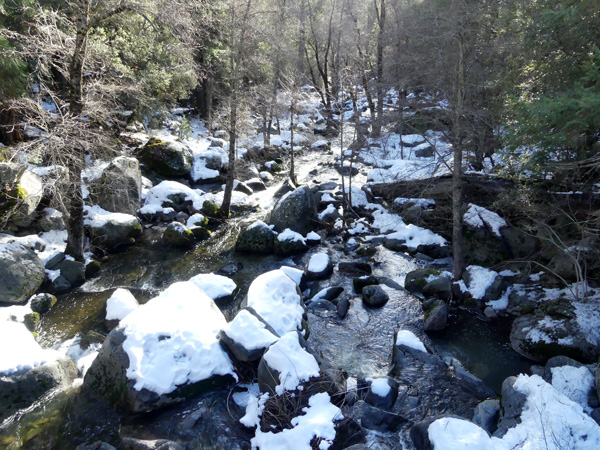 The south fork of Chilnualna Creek in winter. Photo by Richard Stover The south fork of Chilnualna Creek in winter. Photo by Richard Stover
The snow on the South Fork of Chilnualna Creek enhanced our festive mood.
We had fun practicing pronouncing the name of this lovely creek with its falls.
What IS 30 X 30 and Why?
By Vicky Hoover and Anne Henny
January, 2022
A global movement seeks to conserve 30 percent of lands and coastal waters by the year 2030—or “30 by 30”.
Biologists tell us we’re in a global crisis for biodiversity, as countless species of animals and plants could be extinct in 50 to 100 years—unless we drastically change our sprawling land use and protect far more wild habitat; probably at least “Half Earth” is needed as places where nature can dominate. Aiming for 30 percent over the next decade is seen as an achievable “stepping stone” toward an eventual 50 percent—called “Nature Needs Half”. The Sierra Club has joined the global Nature Needs Half initiative.
We need to preserve Nature so that Nature can preserve us – as, truly, Nature is our support system.
California became the first state to adopt “30 by 30” as official state policy, in an October 2020 Executive Order by Governor Gavin Newsom. And in January 2021, a week after his inauguration, President Biden gave a national 30 by 30 executive order—his program is dubbed “America the Beautiful.”
In addition to fighting species extinction, “30 by 30” directly addresses climate change: protecting natural lands enhances the carbon sequestration ability of lands and waters – whether unlogged forests, undisturbed desert soils, grasslands, or marine habitats.
Thus, 30 by 30 connects the fight for biodiversity and the fight to mitigate the climate crisis. Sierra Club volunteers and staff have long pushed both these goals, and now 30 by 30 embraces both and ties them together.
At present some 12 percent of the nation and about 22 percent of California (with more than average protected public lands) is considered “conserved”.
|
Make a contribution to the Sierra Club today!
Your local Sierra Club Chapter and Group needs financial support to carry on our fight to protect the spectacular coast, valleys, and mountains.
We cannot fight for endangered and at risk wildlife without money. We cannot save precious forests, mountains, watersheds, and open spaces without money.
We know that you care about the environment from your membership in the Club. Now we need your help.
Much of the work of the Club consists of non-glamorous, roll-up-your-sleeves labor. Volunteers study EIRs and make comments; activists get government staff reports and keep tabs on proposed developments and policy changes; sometimes the Club files suit.
Please help us continue to protect and preserve the Central Coast. To make a donation please send a check made out to ‘Sierra Club' to
Sierra Club Ventana Chapter, P O Box 5667, Carmel, CA 93921-5667
Contributions to the Sierra Club are not tax deductible. To send tax deductible contributions, which mainly support legal actions when they become necessary, make your check out to ‘Sierra Club Foundation' instead.
|
|


 From the top of Paulina Peak one can see the Newberry Caldera containing Paulina Lake on the left and East Lake on the right. The flow lines of the Big Obsidian Flow are clearly visible from this viewpoint. The Central Pumice Cone is between the two lakes.
From the top of Paulina Peak one can see the Newberry Caldera containing Paulina Lake on the left and East Lake on the right. The flow lines of the Big Obsidian Flow are clearly visible from this viewpoint. The Central Pumice Cone is between the two lakes. On the summit of Paulina Peak. Mt. Bachelor and South Sister on the left horizon.
On the summit of Paulina Peak. Mt. Bachelor and South Sister on the left horizon. Paulina Falls.
Paulina Falls. These bold Grey Jays swarmed our car to clean our windshield.
These bold Grey Jays swarmed our car to clean our windshield. Scenic and biologically diverse, Work Memorial Park in The sheer walls of Goddard Canyon drop down to the South Fork of the San Joaquin River. (photo Richard Stover).
Scenic and biologically diverse, Work Memorial Park in The sheer walls of Goddard Canyon drop down to the South Fork of the San Joaquin River. (photo Richard Stover). Florence Lake Ferry landing with pointed Mt. Shinn on center horizon across the lake. (photo Richard Stover).
Florence Lake Ferry landing with pointed Mt. Shinn on center horizon across the lake. (photo Richard Stover). Click Photo for larger image.
Click Photo for larger image. Our camp.
(photo Richard Stover).
Our camp.
(photo Richard Stover). On one of our layover days we hiked above the canyon looking for the remains of the Hell for Sure Trail.
(photo Richard Stover).
On one of our layover days we hiked above the canyon looking for the remains of the Hell for Sure Trail.
(photo Richard Stover). Returning to Florence Lake.
(photo Richard Stover).
Returning to Florence Lake.
(photo Richard Stover). Trees with Snow on Branches, "Half Dome, Apple Orchard, Yosemite,” California by Ansel Adams, founder of Ventana Chapter Sierra Club in 1963. (Photo courtesy of the US National Archives and Records Administration).
Trees with Snow on Branches, "Half Dome, Apple Orchard, Yosemite,” California by Ansel Adams, founder of Ventana Chapter Sierra Club in 1963. (Photo courtesy of the US National Archives and Records Administration). Scenic and biologically diverse, Work Memorial Park in Del Rey Oaks needs protection from planned construction in the nearby areas of the former Fort Ord, urban and airport runoff and the commercial use of Work Memorial Park for large truck traffic.
Scenic and biologically diverse, Work Memorial Park in Del Rey Oaks needs protection from planned construction in the nearby areas of the former Fort Ord, urban and airport runoff and the commercial use of Work Memorial Park for large truck traffic.  Current Cemex plant now in the process of being repurposed as public land.
Current Cemex plant now in the process of being repurposed as public land. Protecting populations of threatened western snowy plovers at the Cemex site and along the Central Coast beaches are a priority for Ventana Chapter.
Protecting populations of threatened western snowy plovers at the Cemex site and along the Central Coast beaches are a priority for Ventana Chapter. Lower Chilnualna Falls Photo by Richard Stover
Lower Chilnualna Falls Photo by Richard Stover The lower part of the trail has a lot of rockwork. Photo by Richard Stover
The lower part of the trail has a lot of rockwork. Photo by Richard Stover Mountain Quail have straight topknots instead of the comma-shaped ones of our local quail..
Mountain Quail have straight topknots instead of the comma-shaped ones of our local quail..  The south fork of Chilnualna Creek in winter. Photo by Richard Stover
The south fork of Chilnualna Creek in winter. Photo by Richard Stover